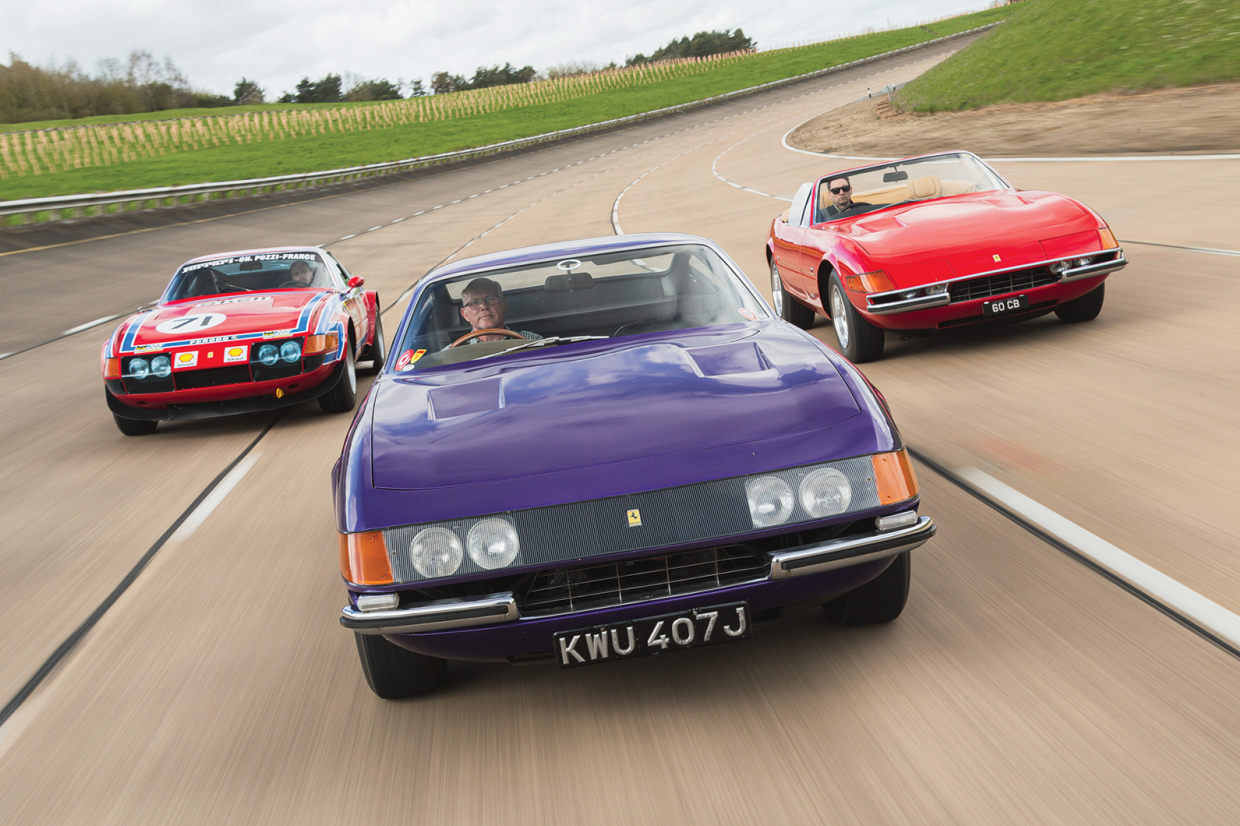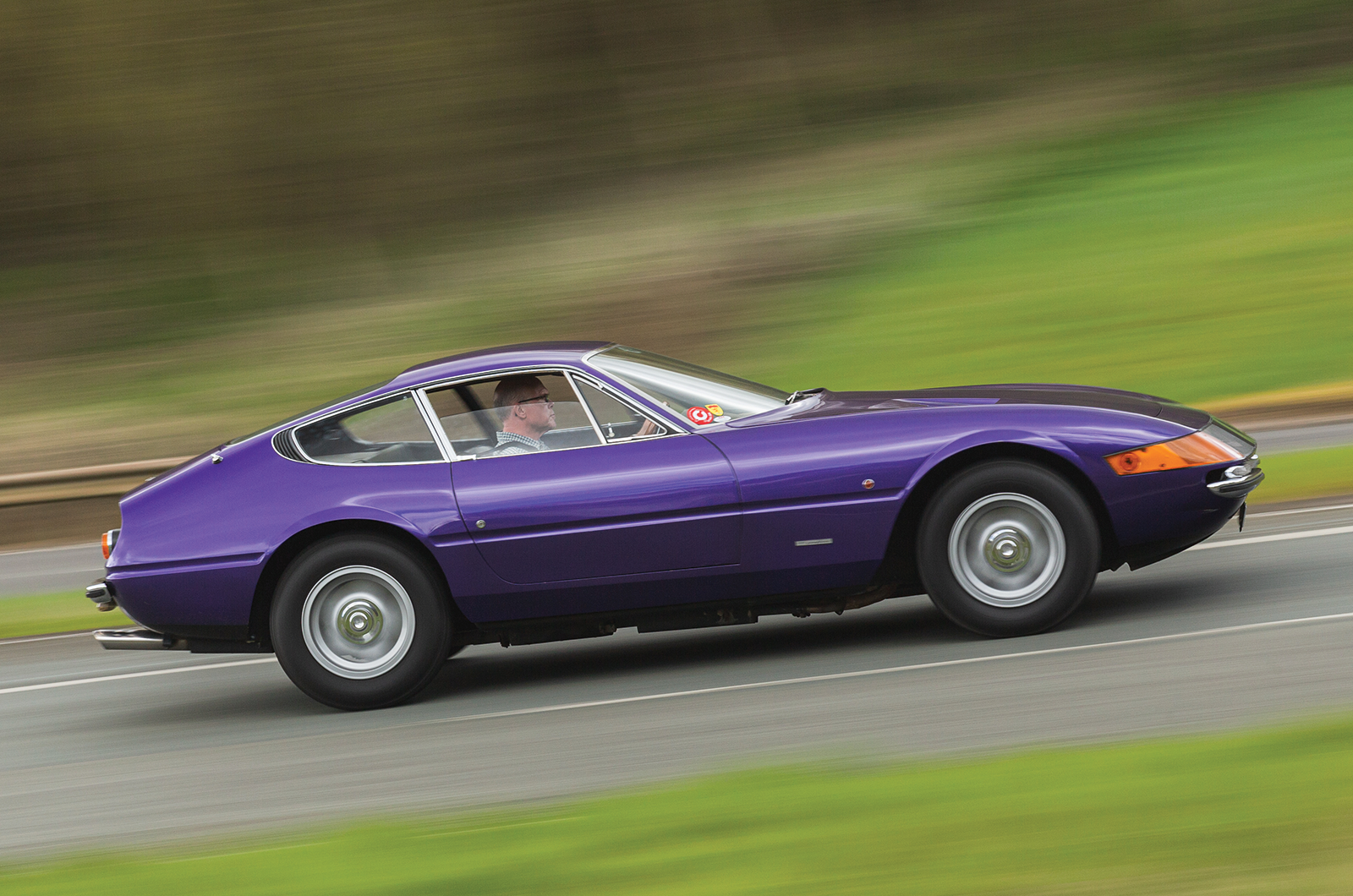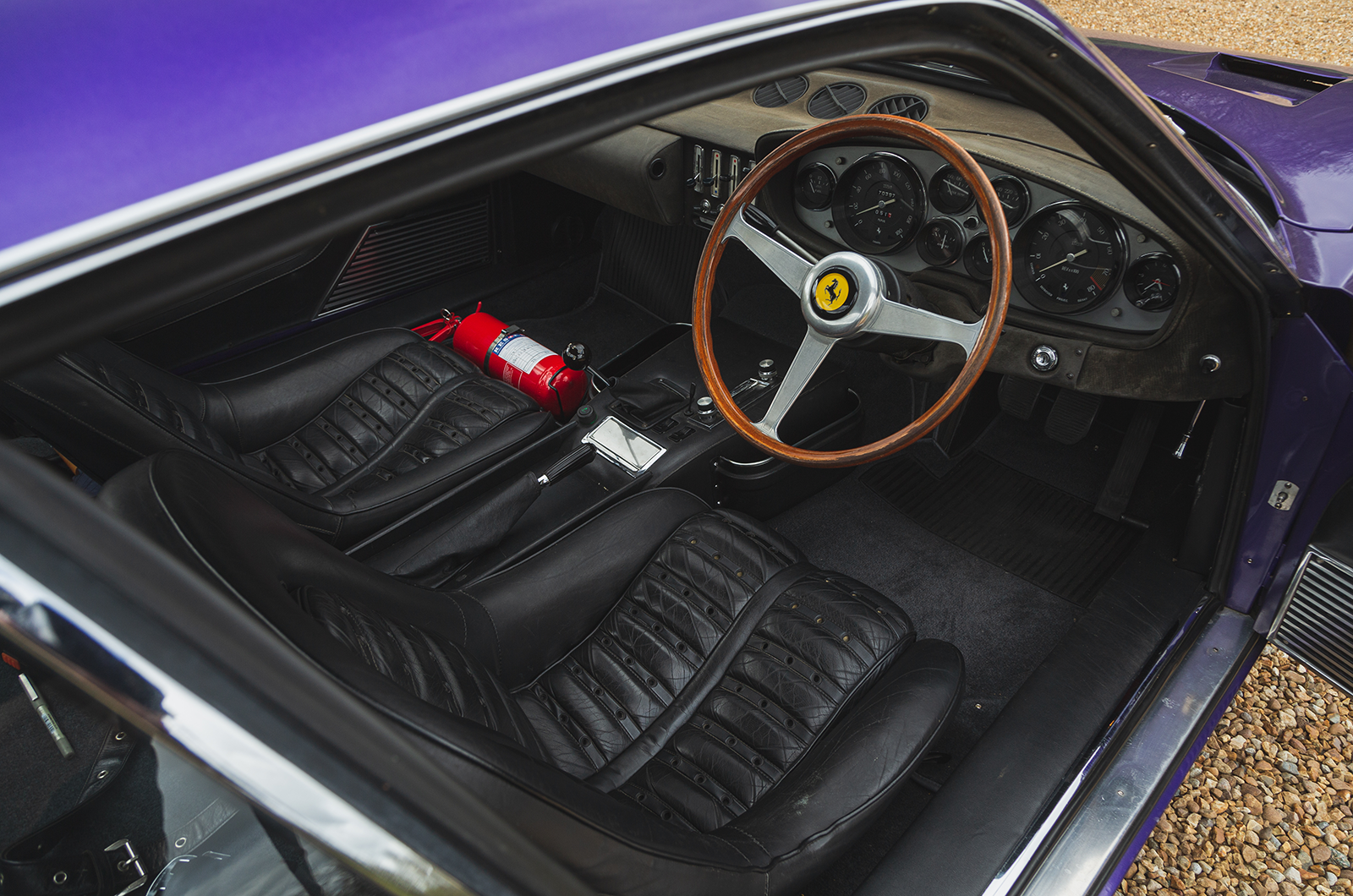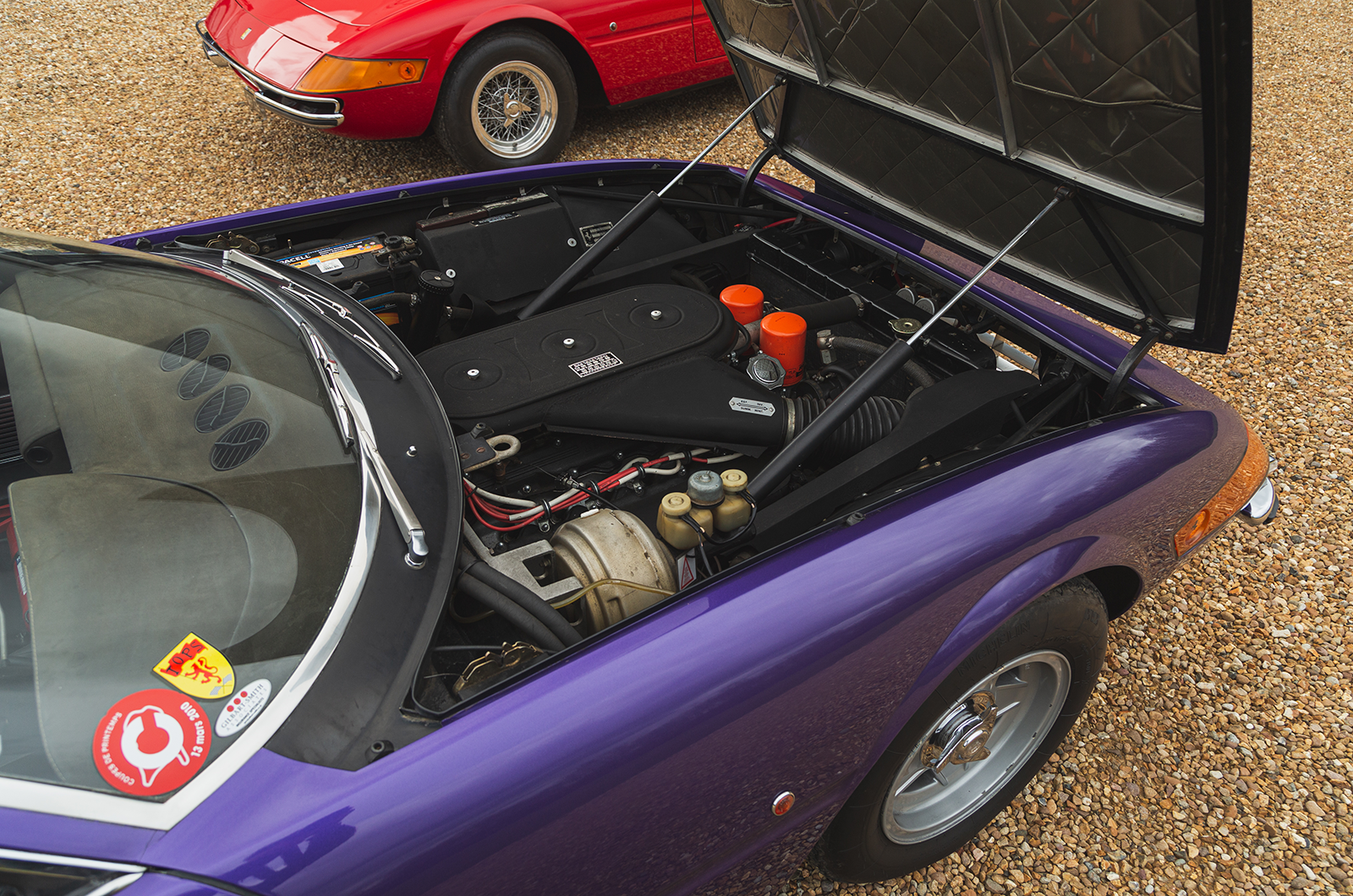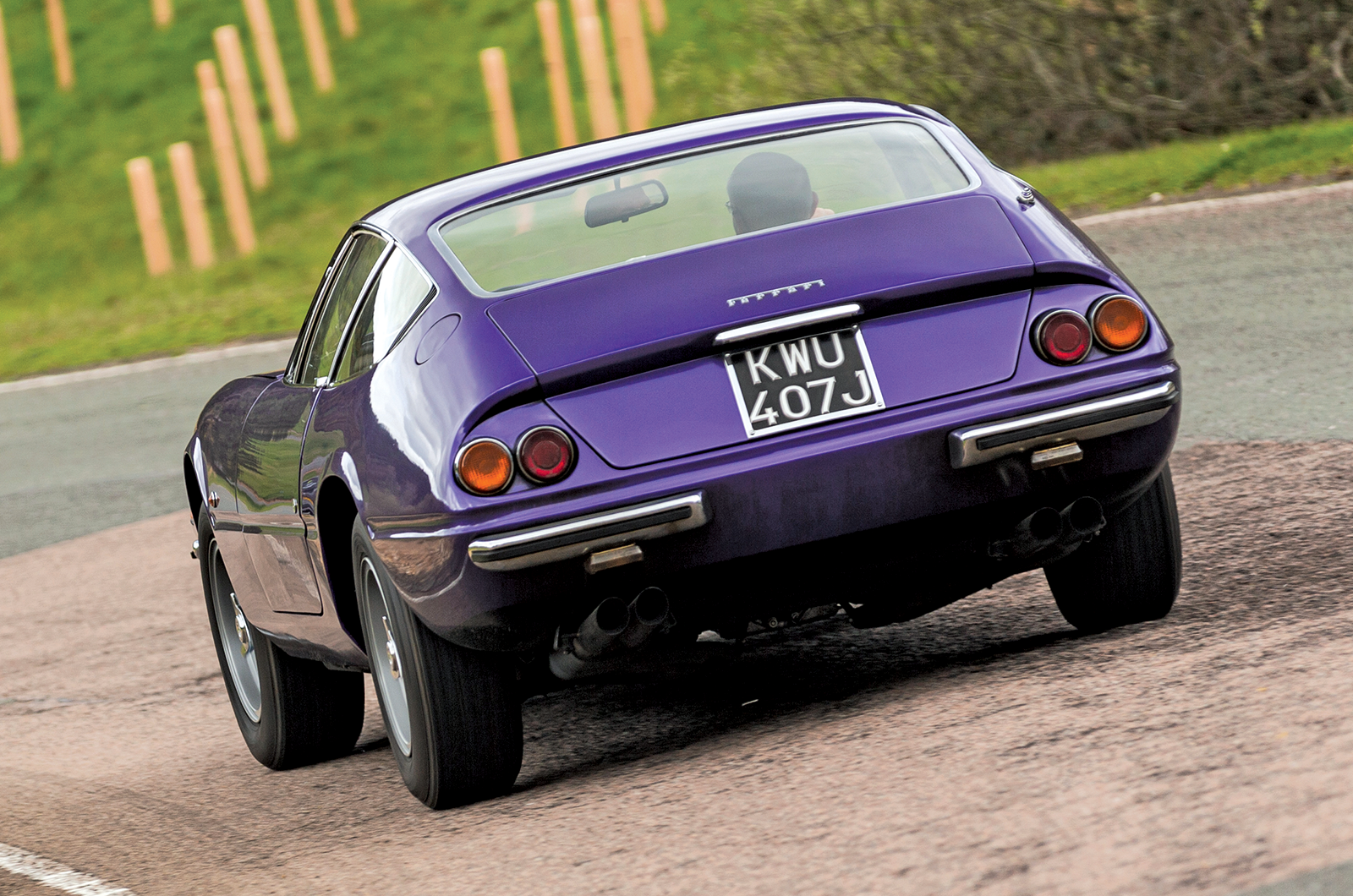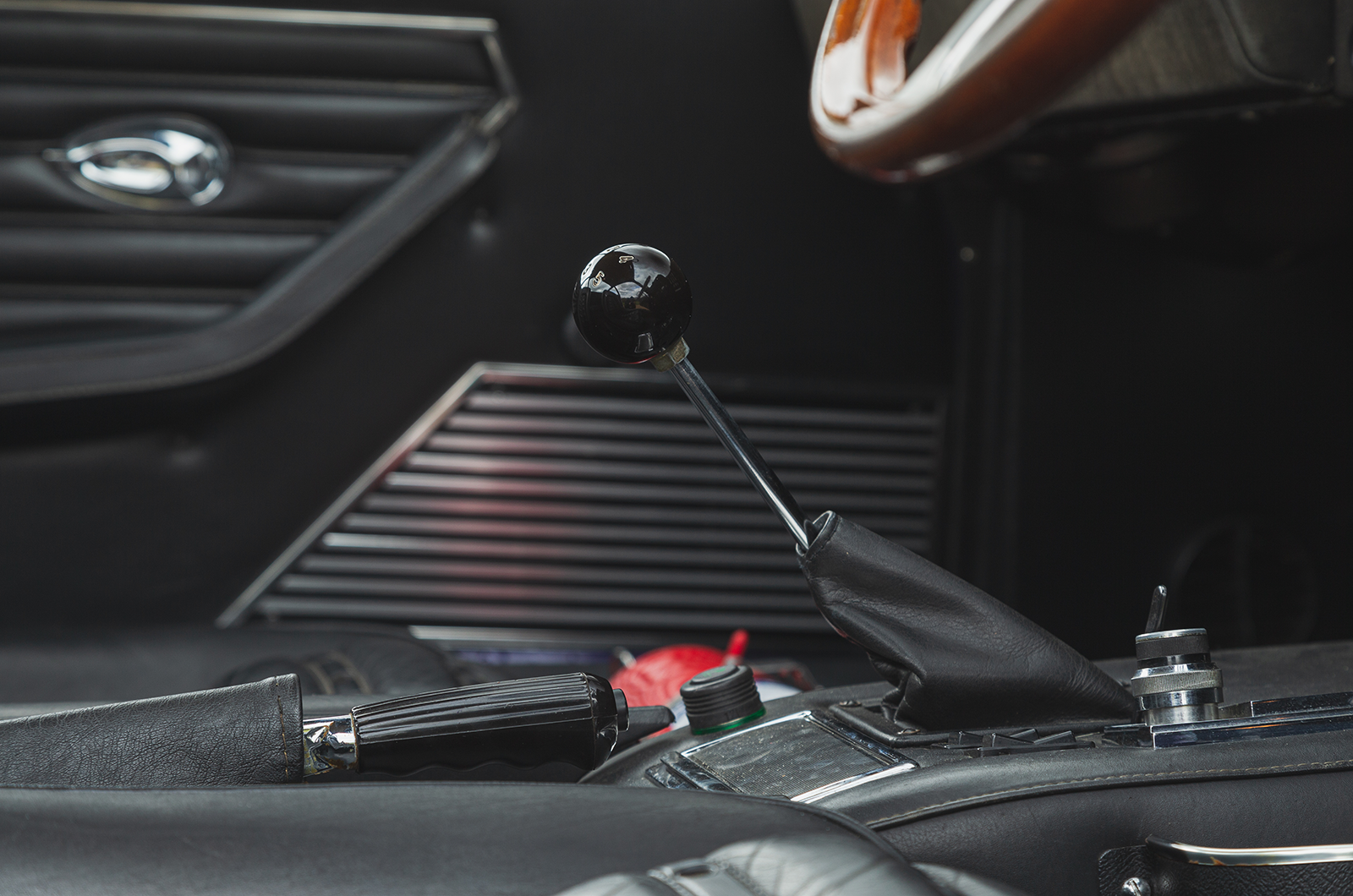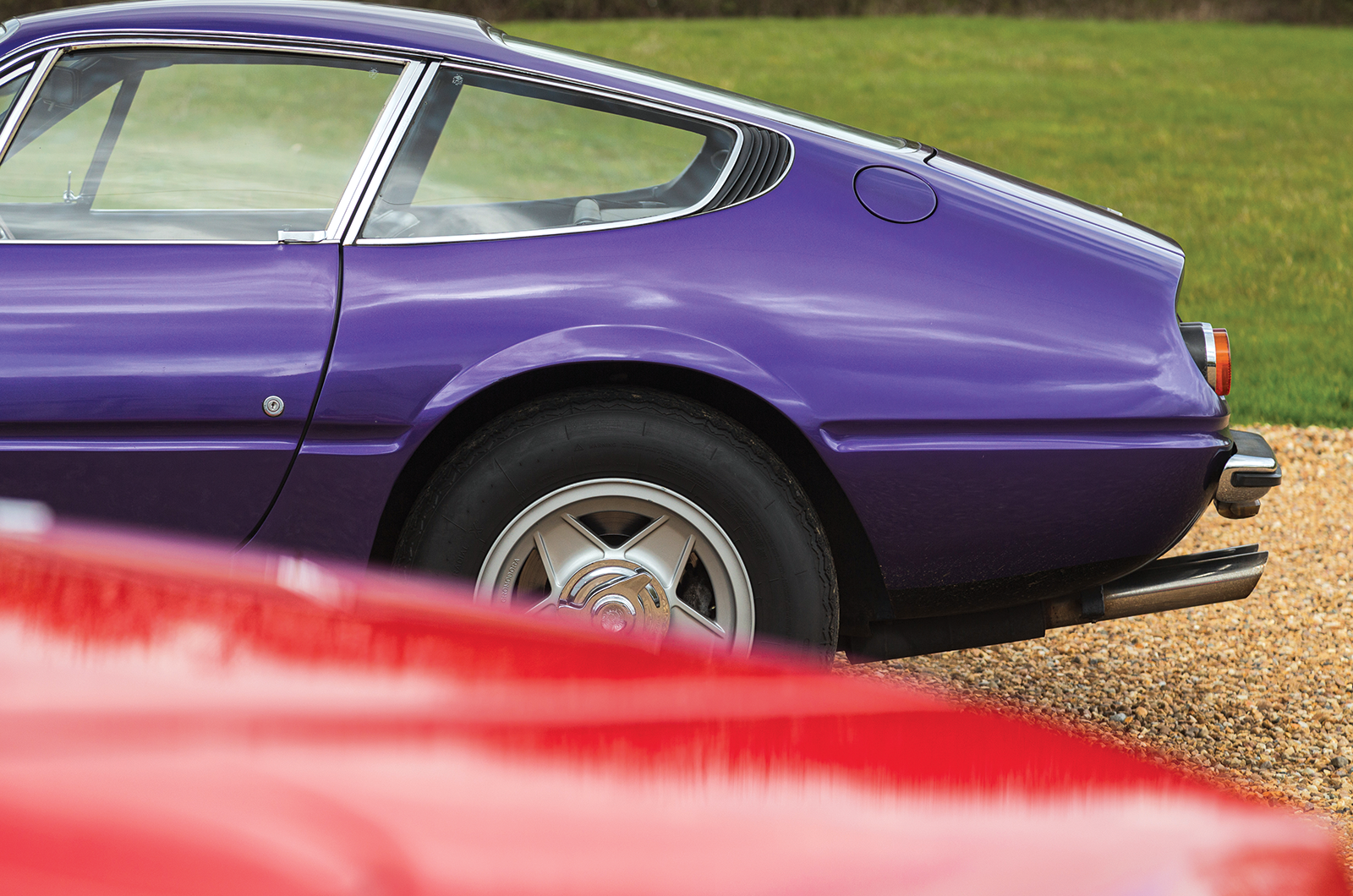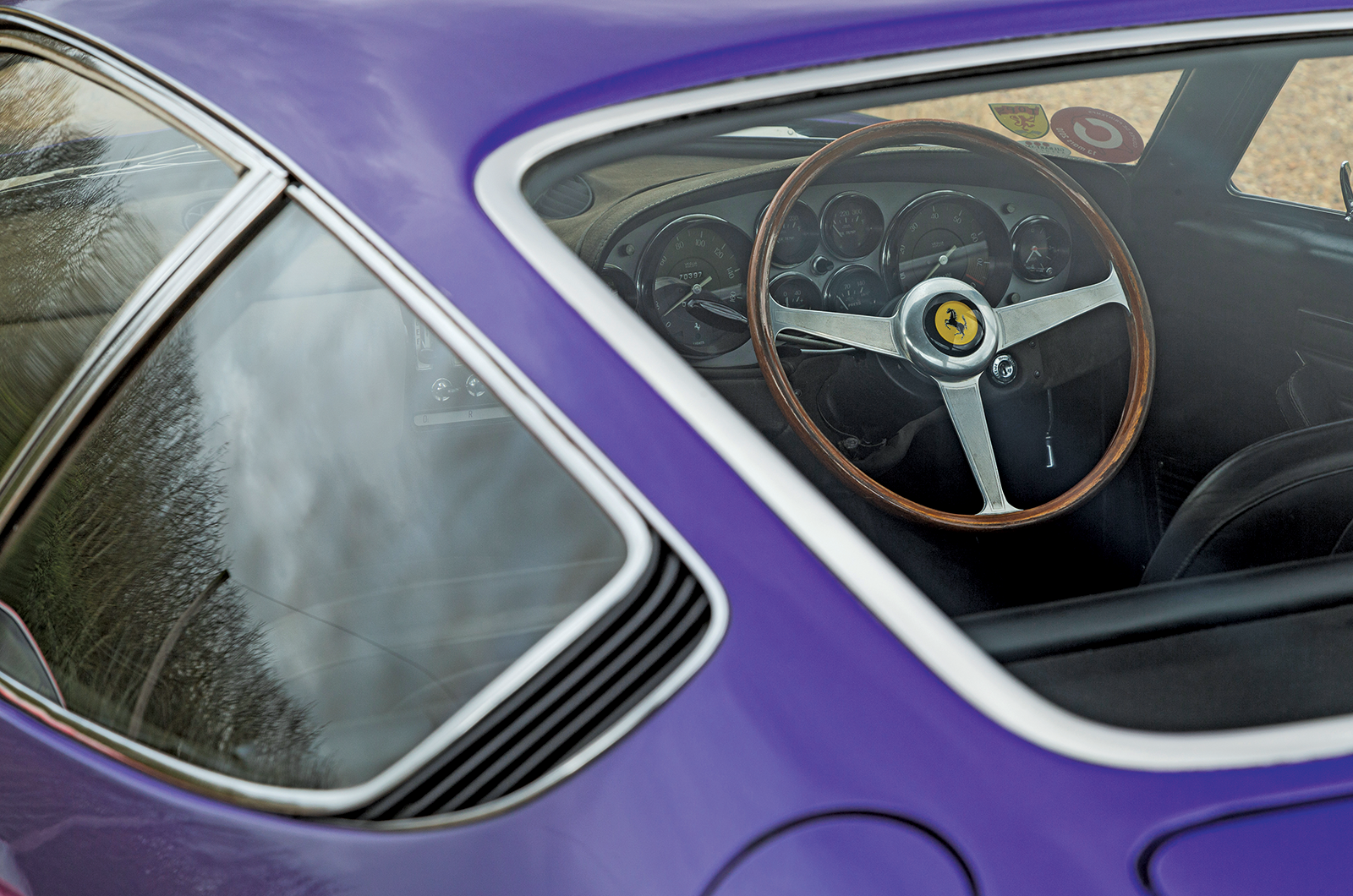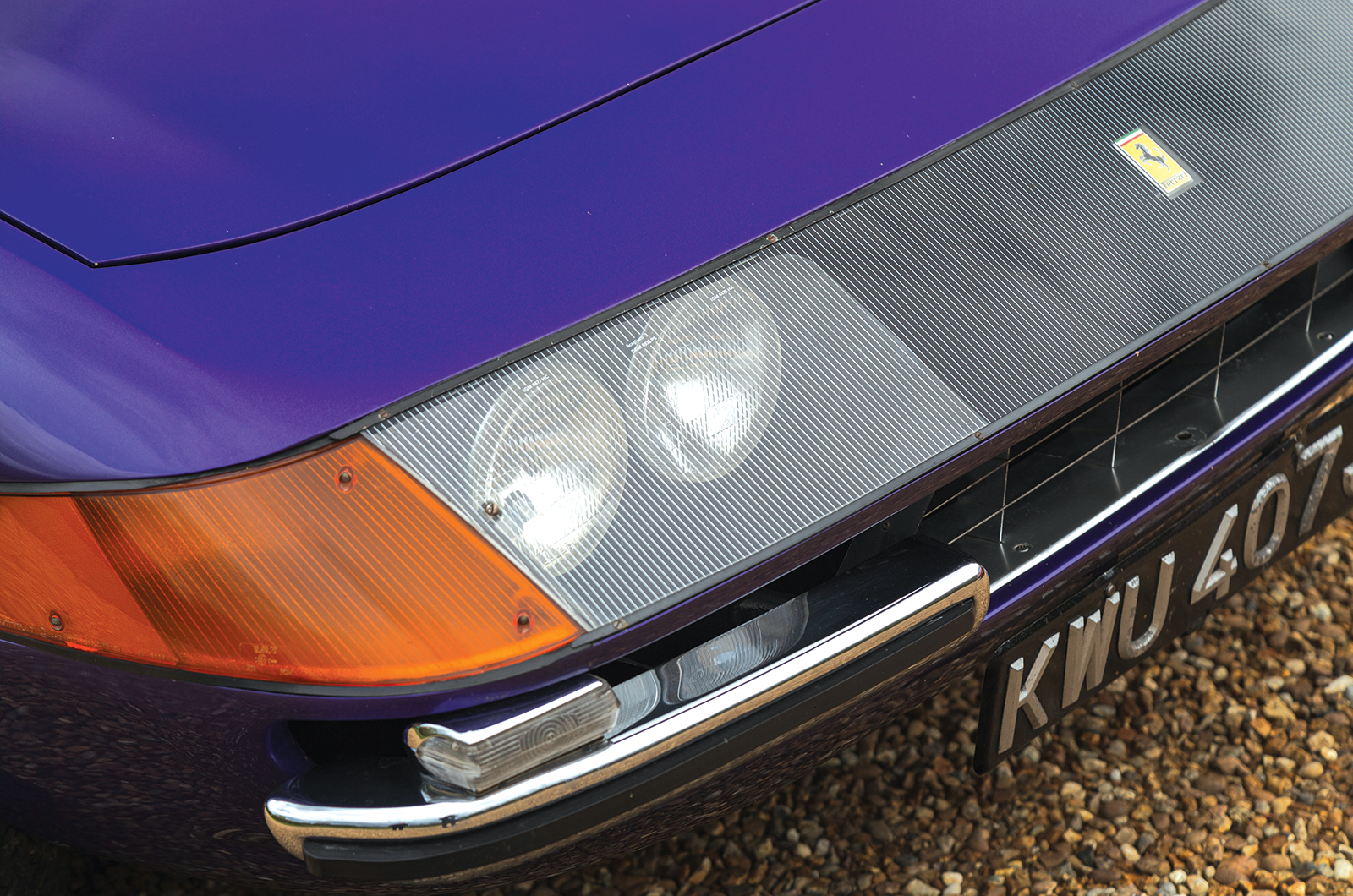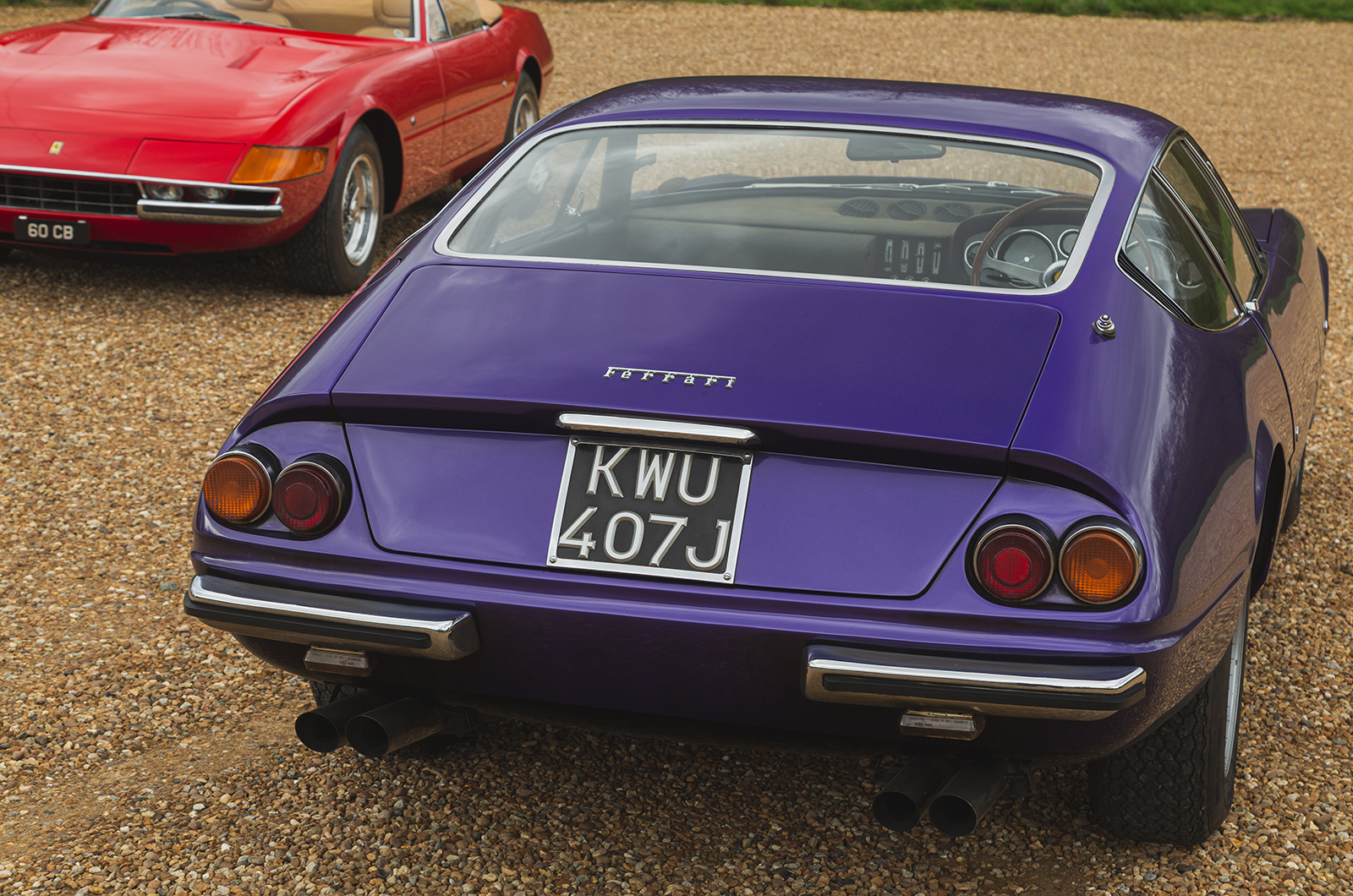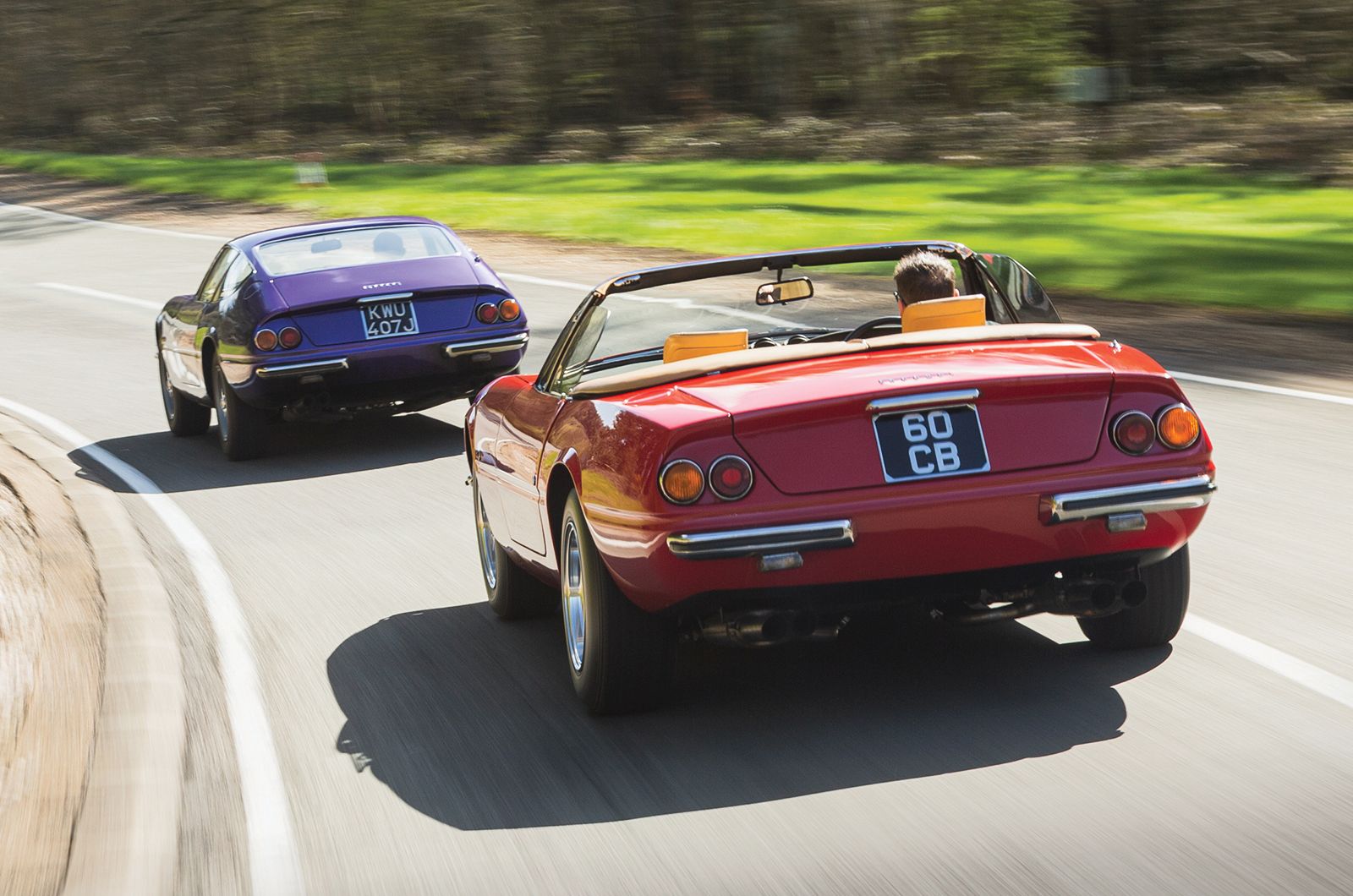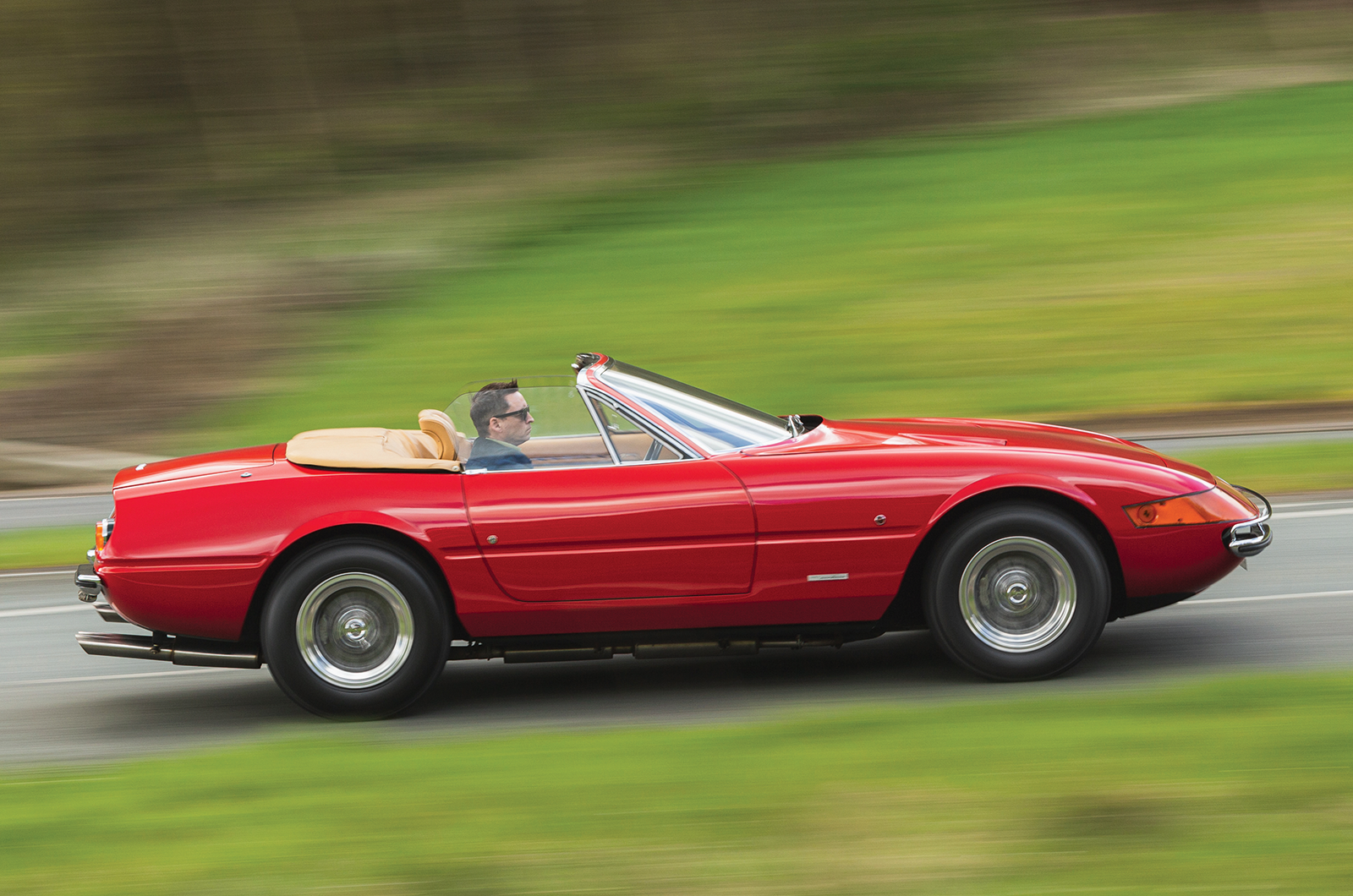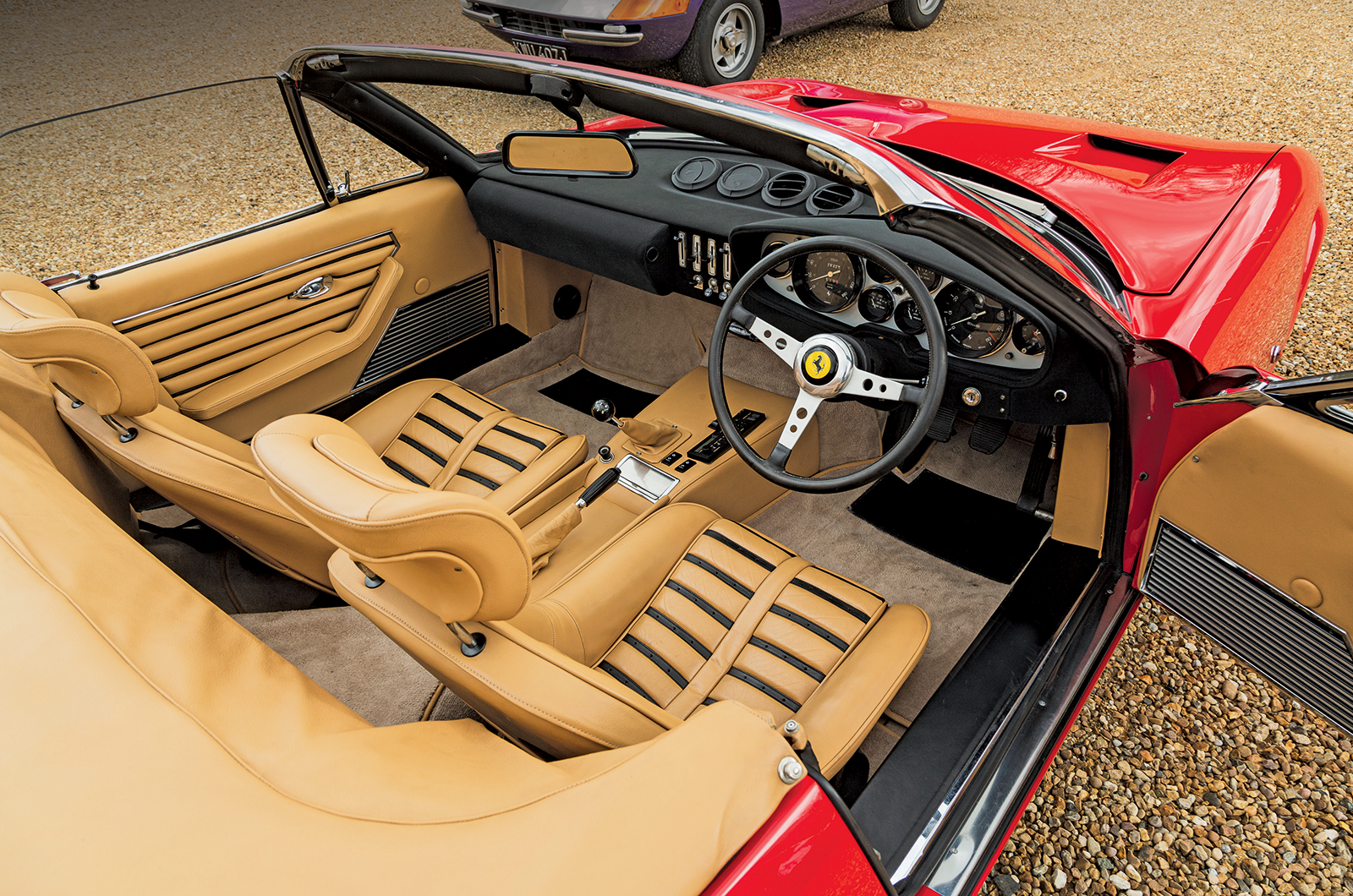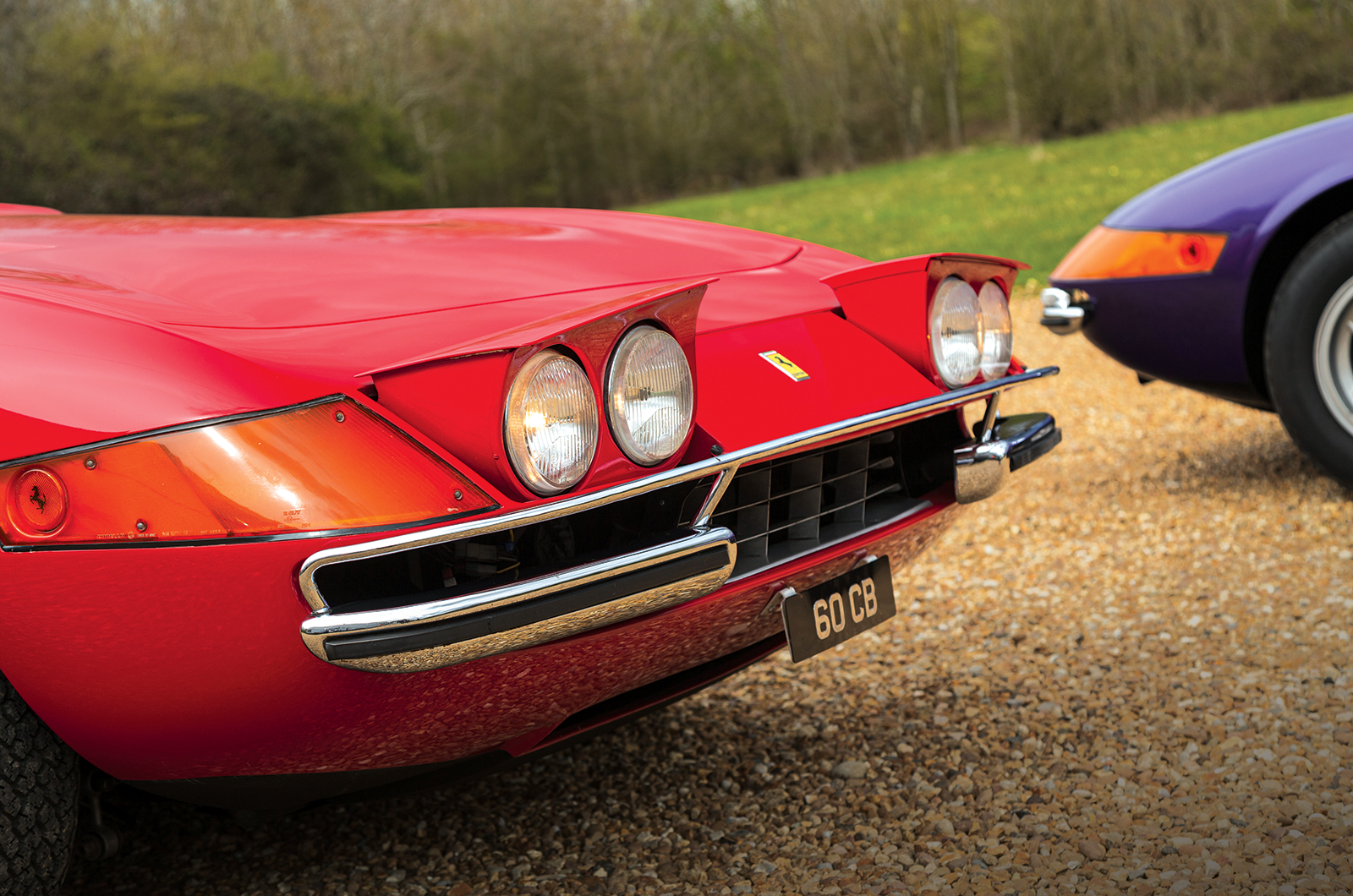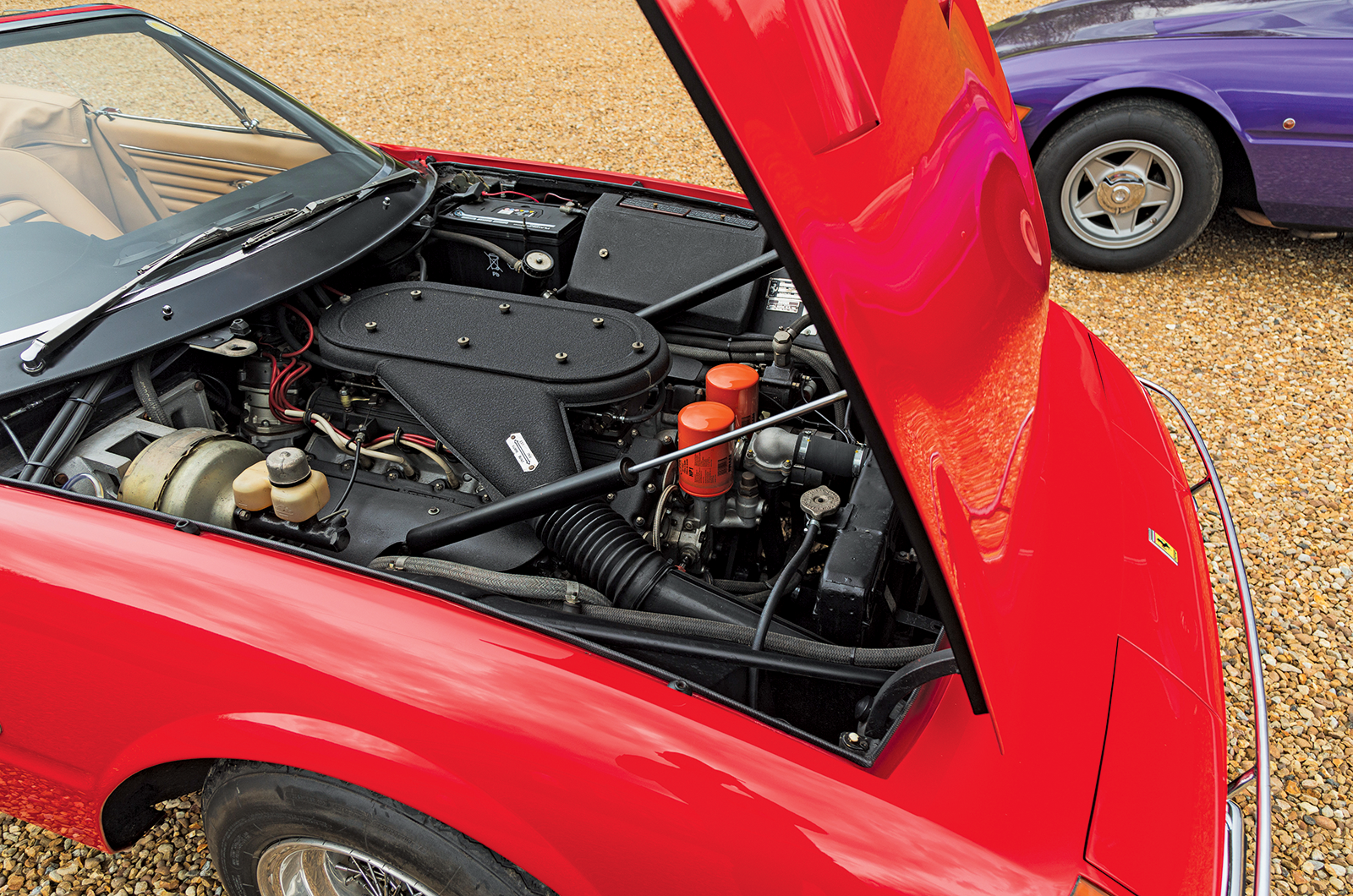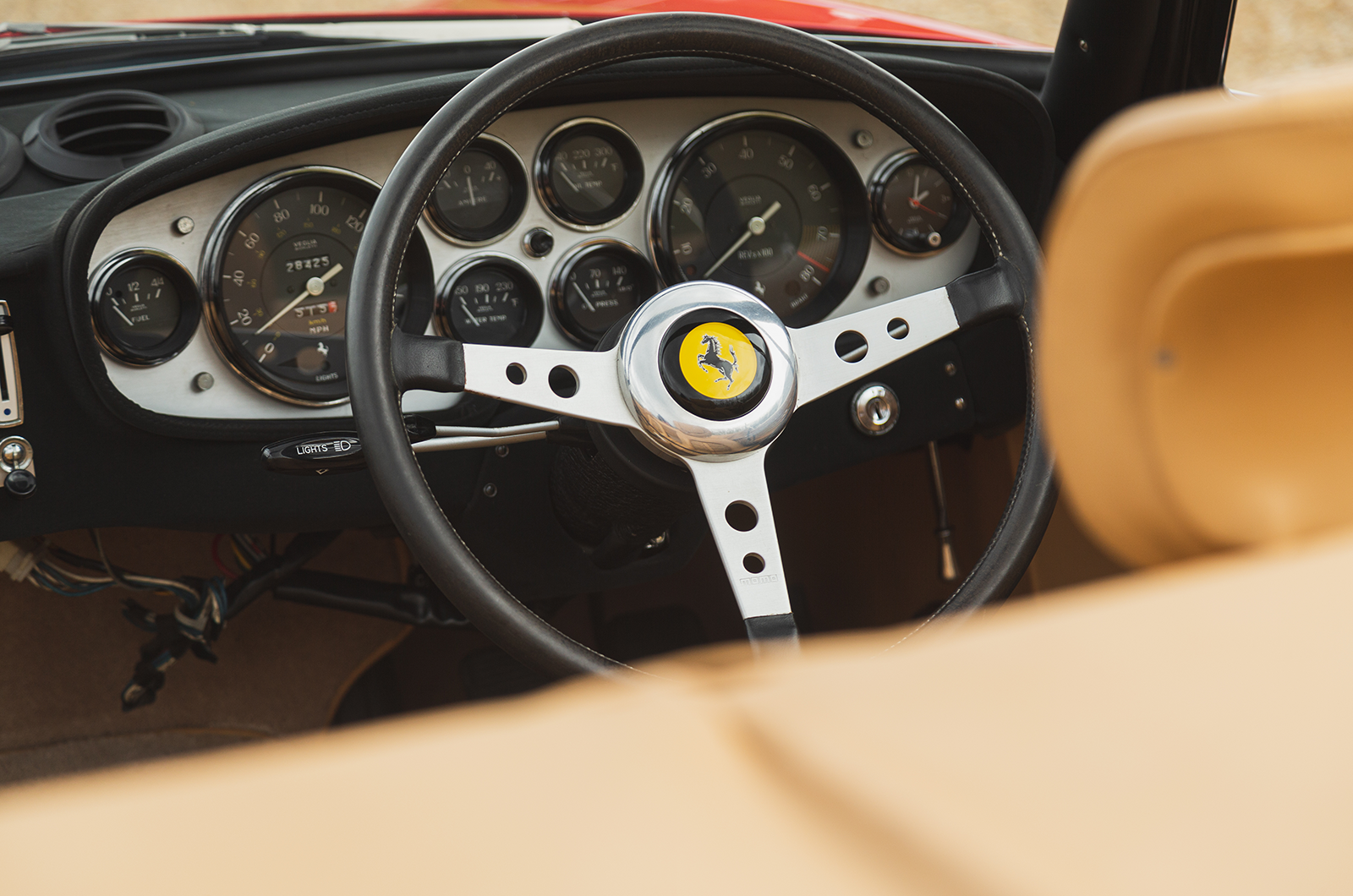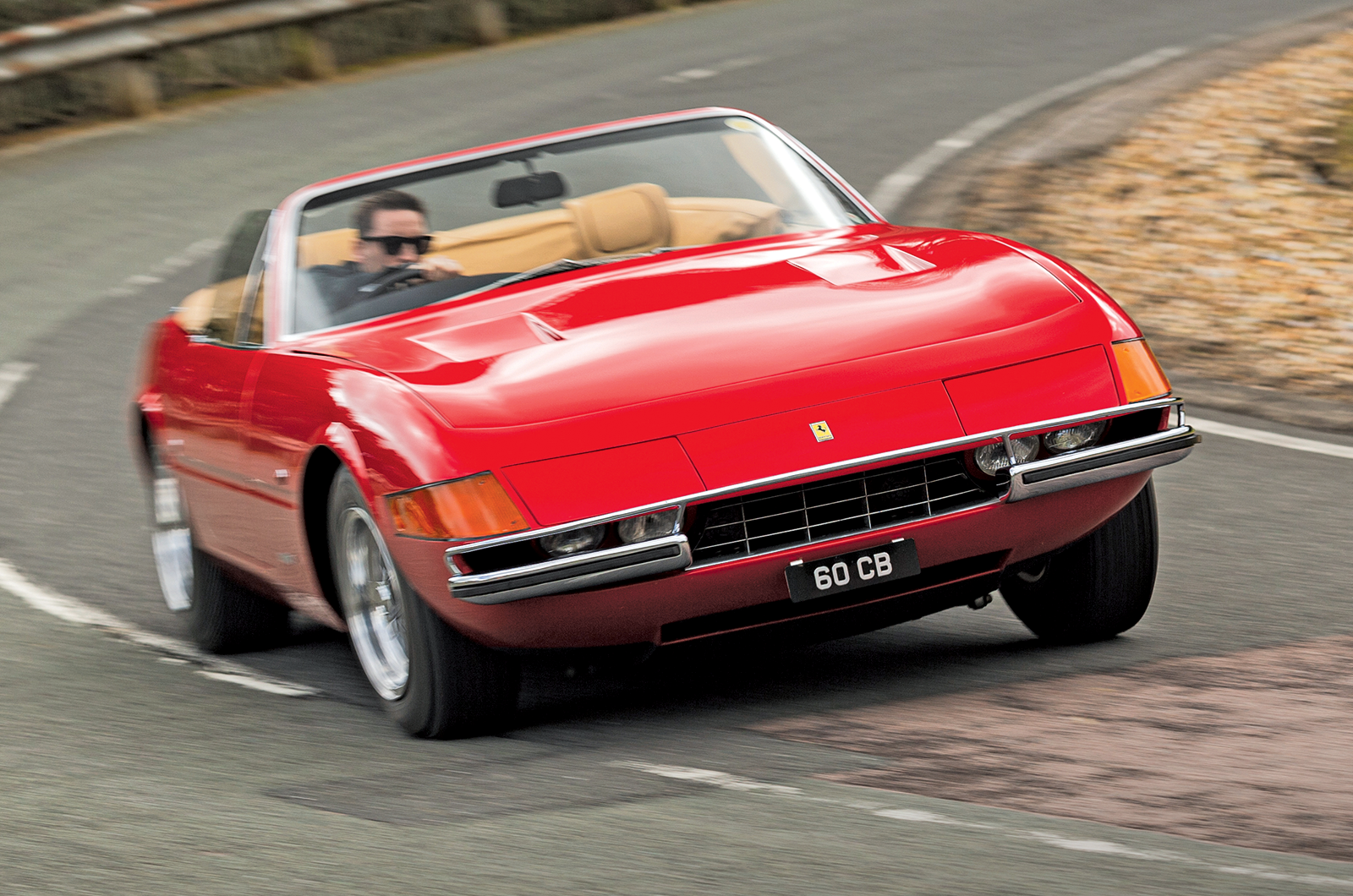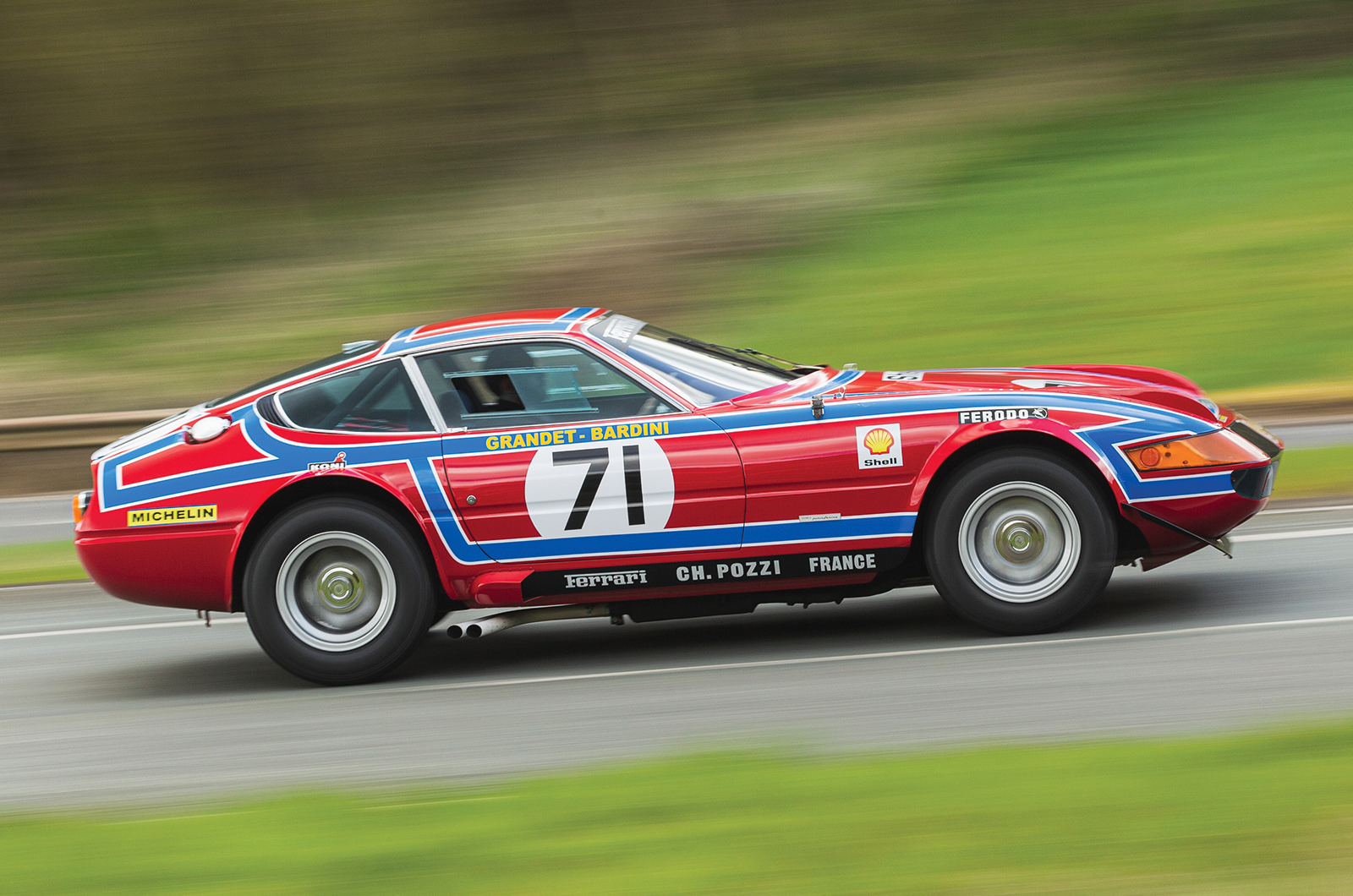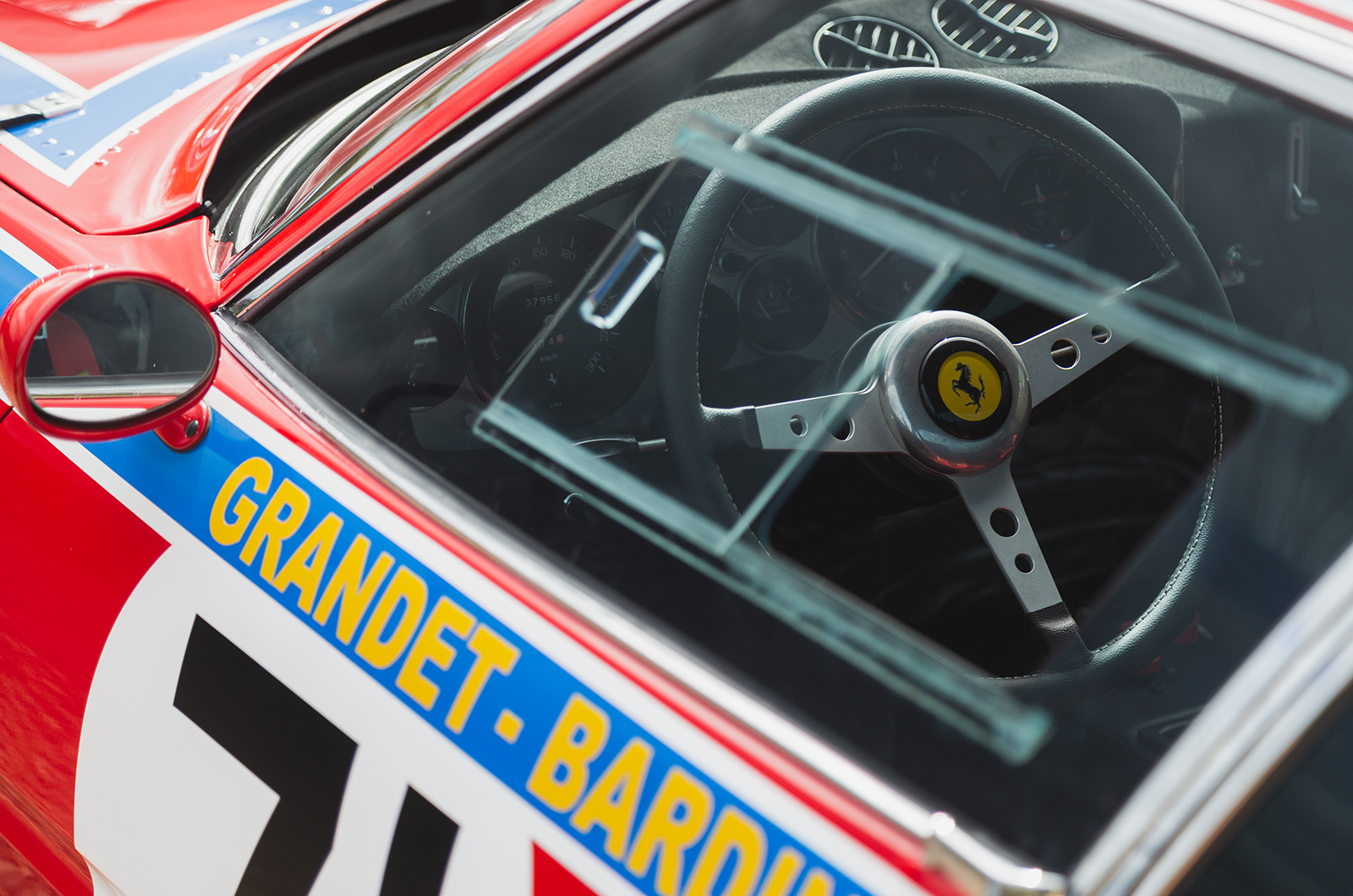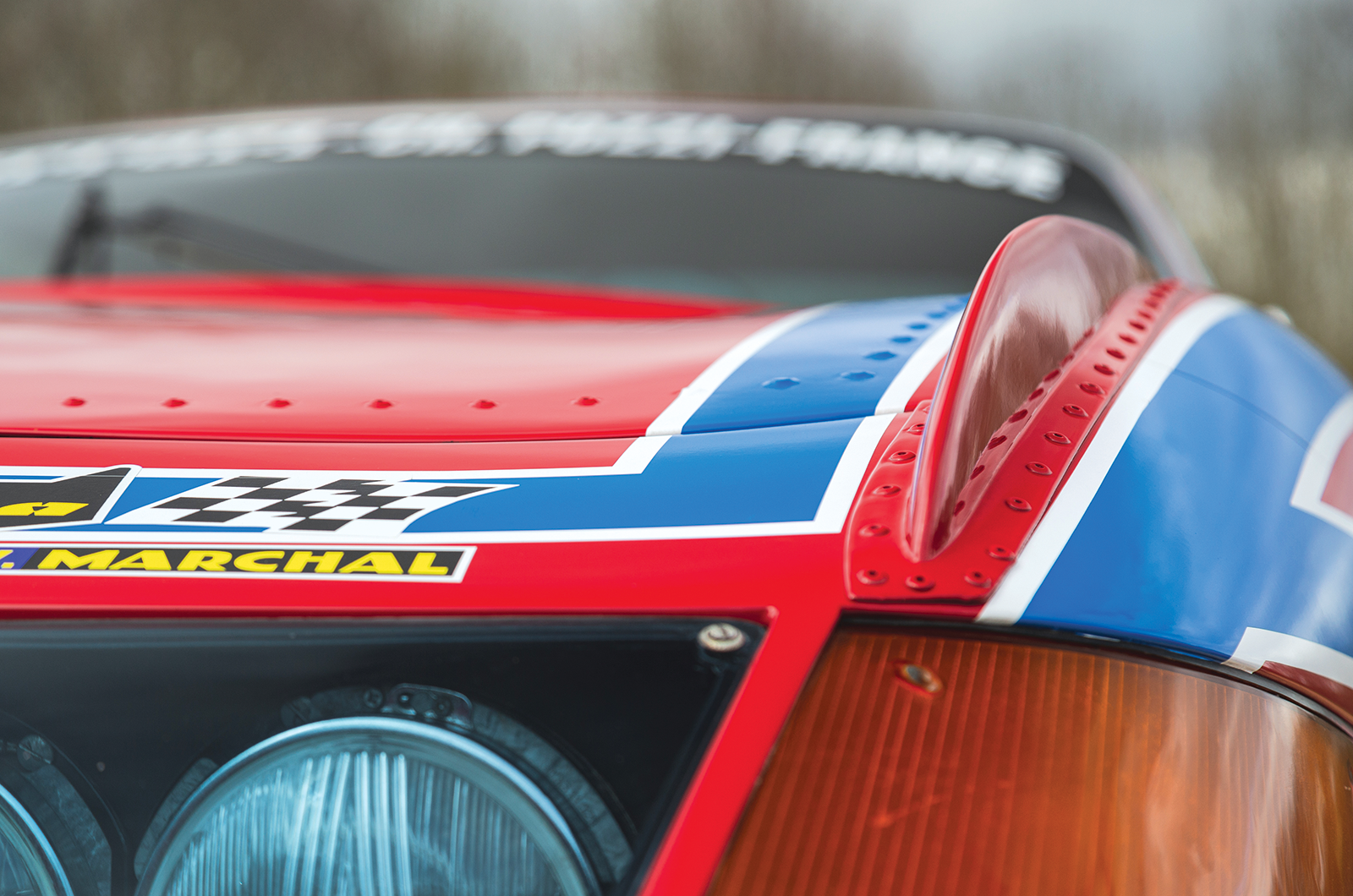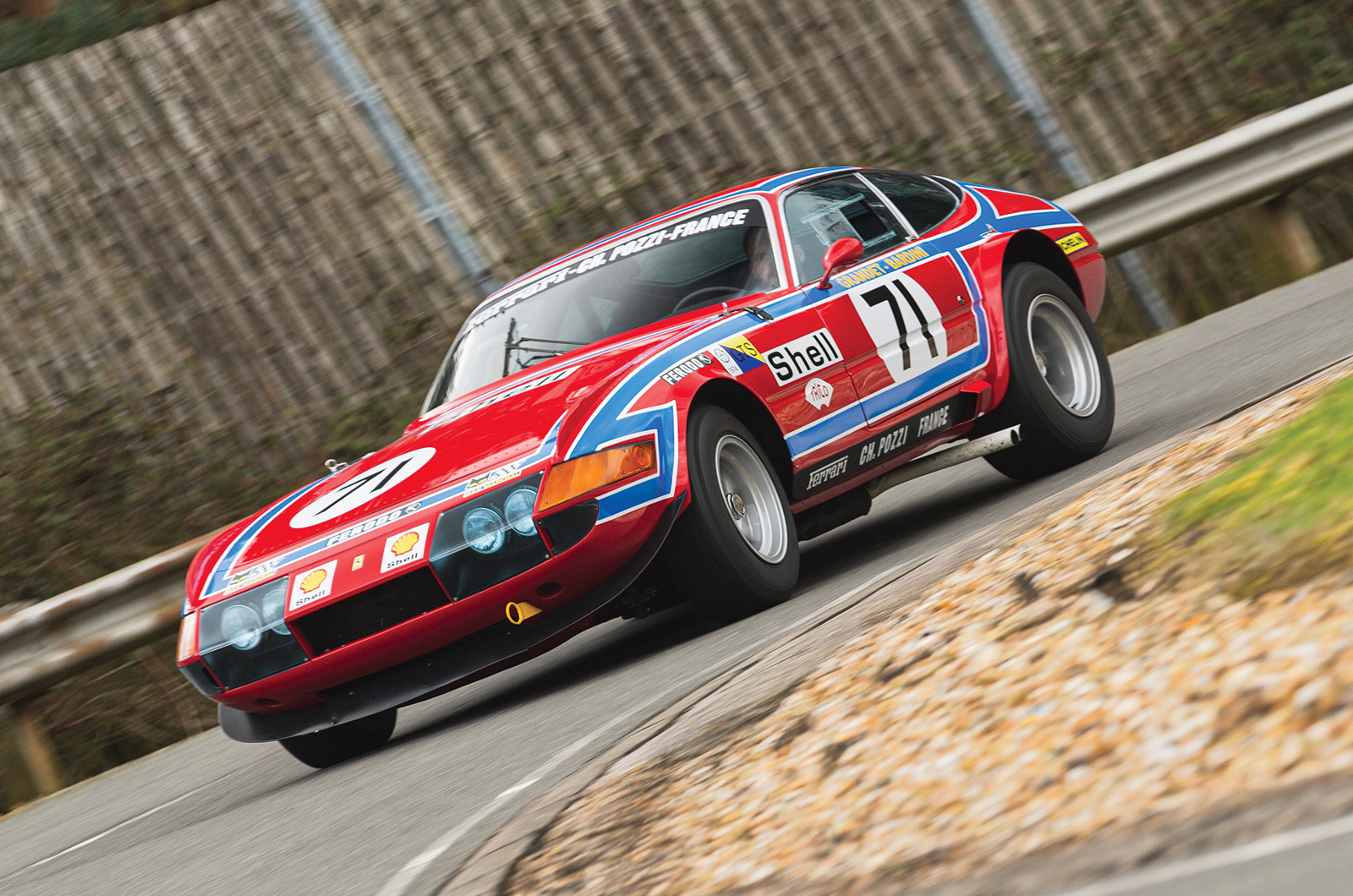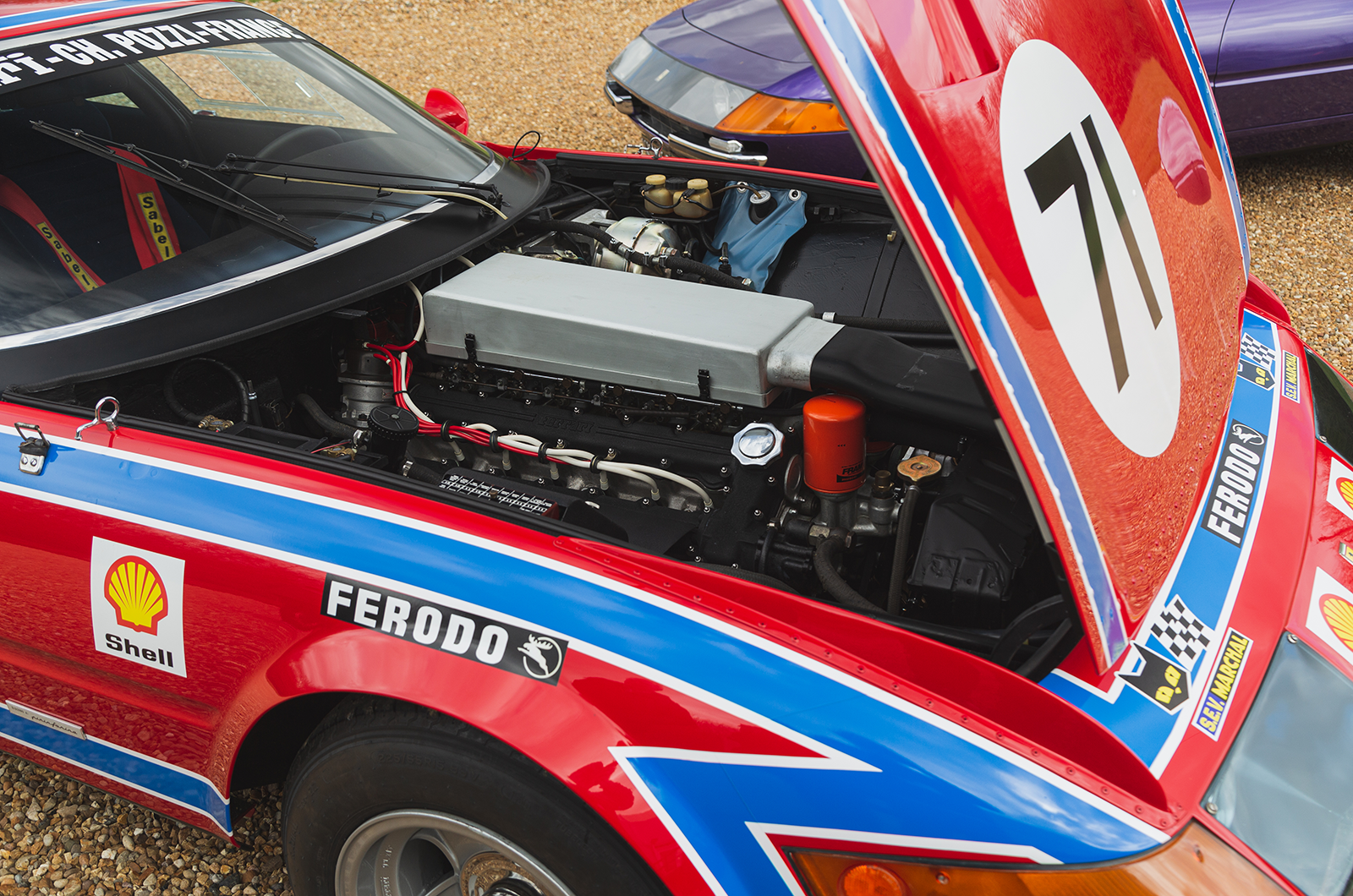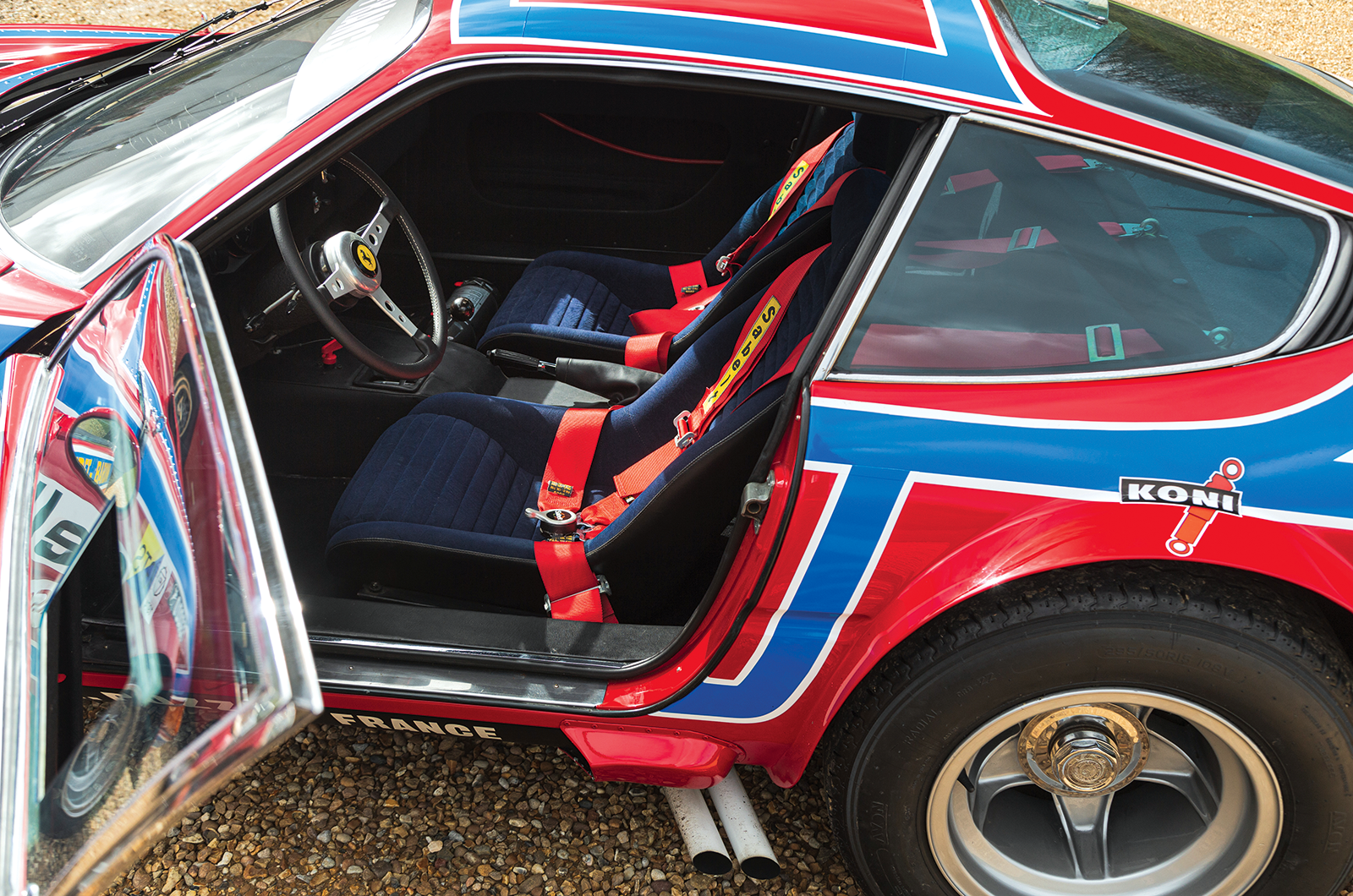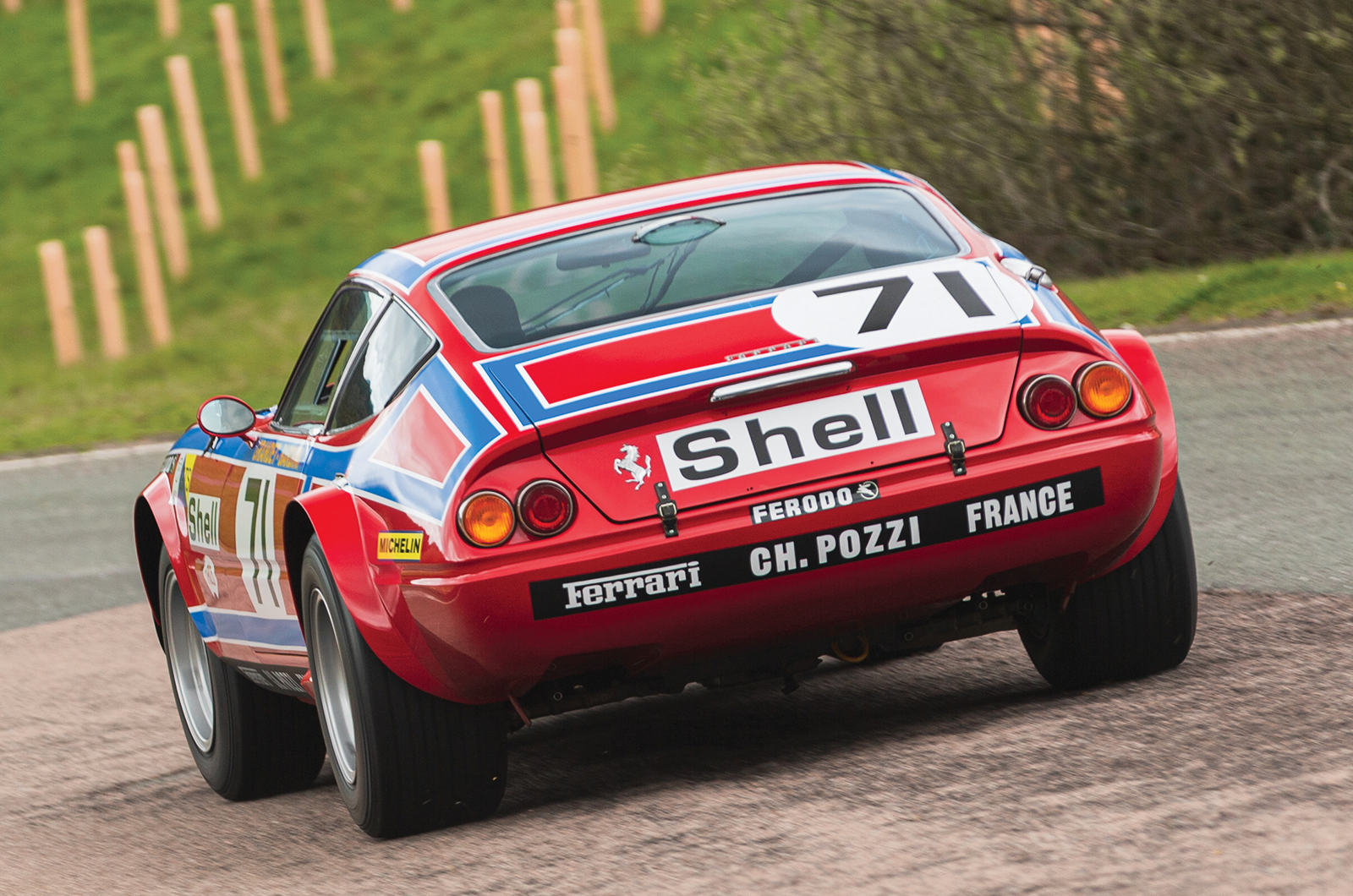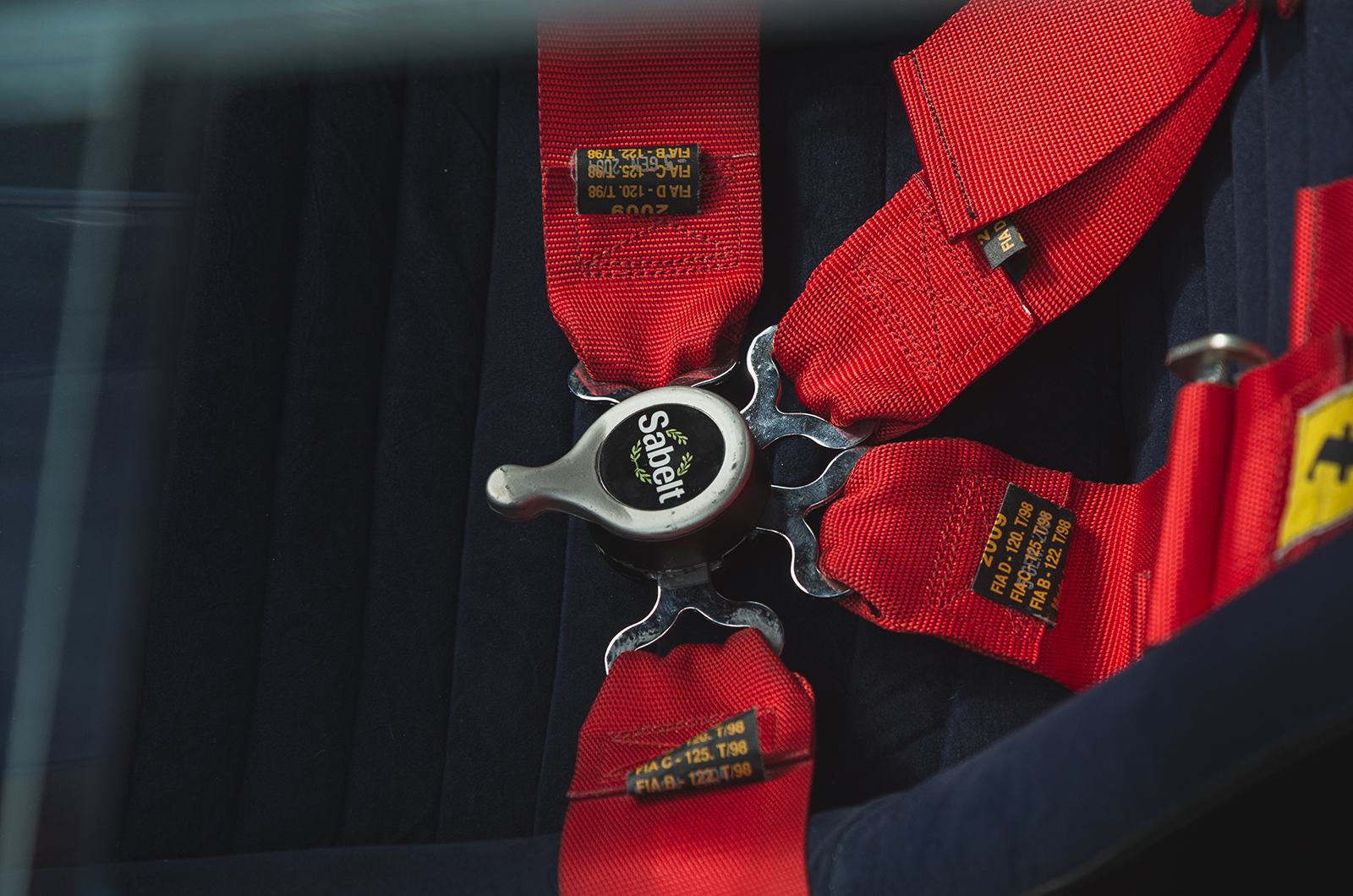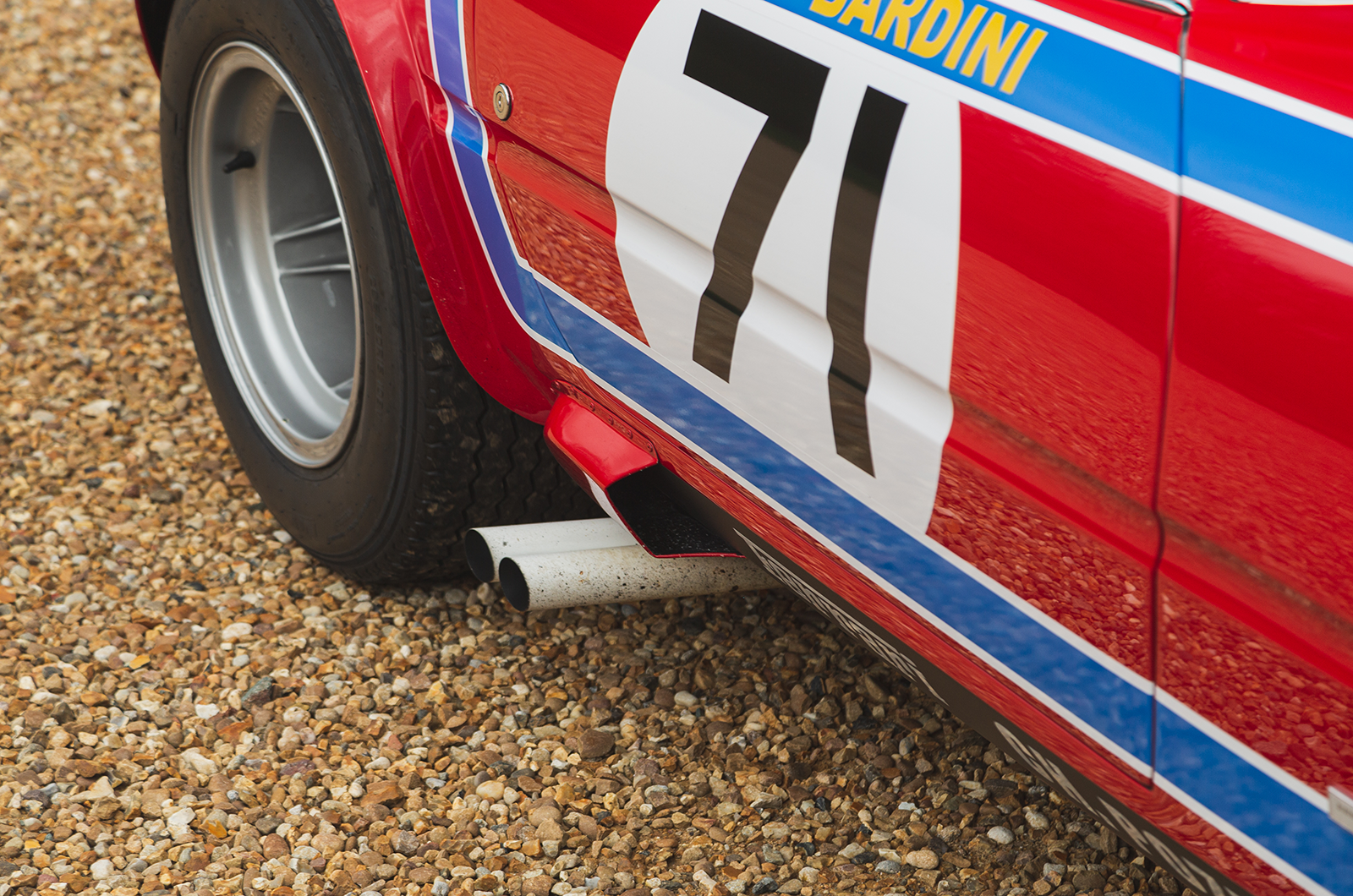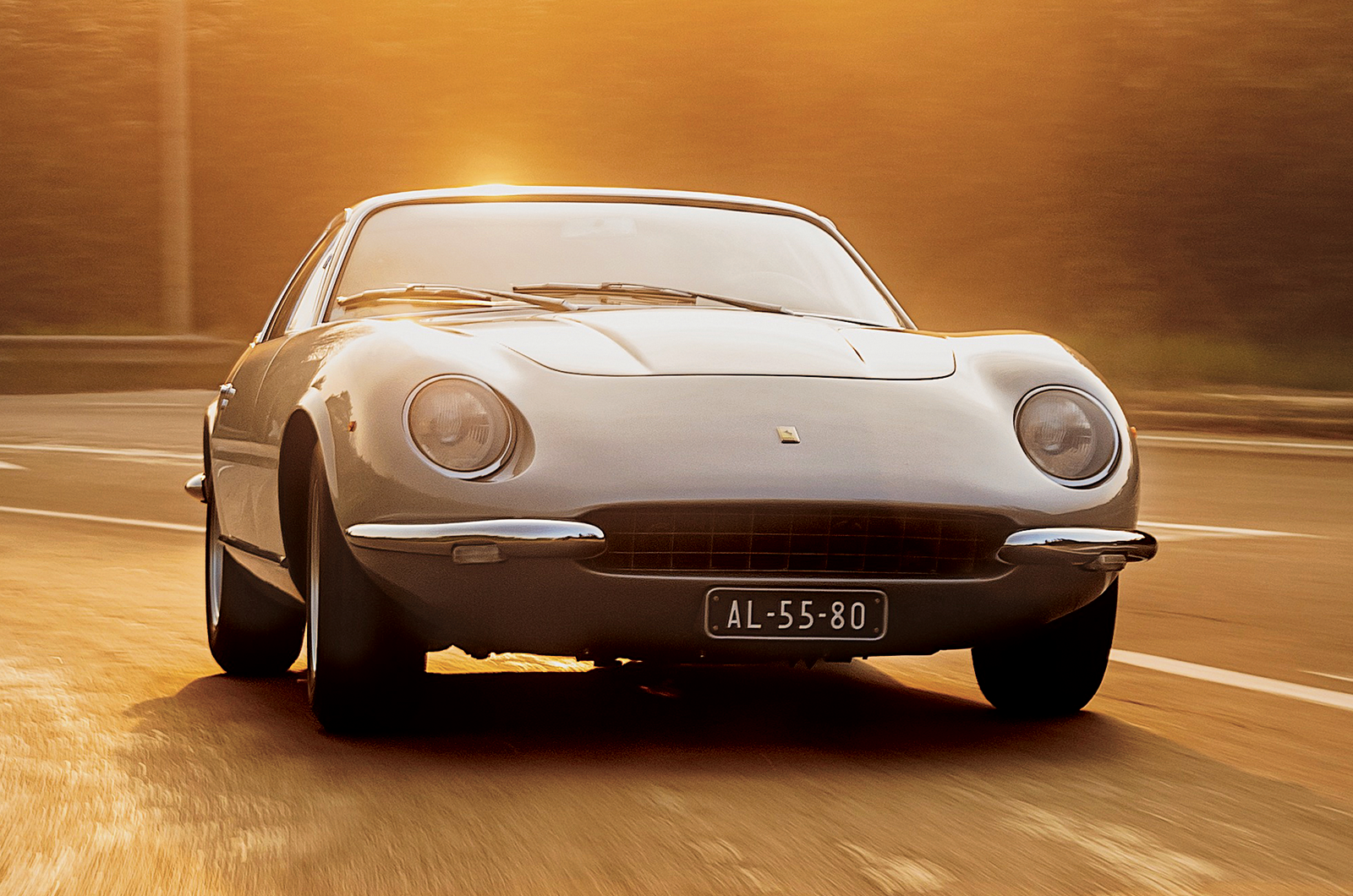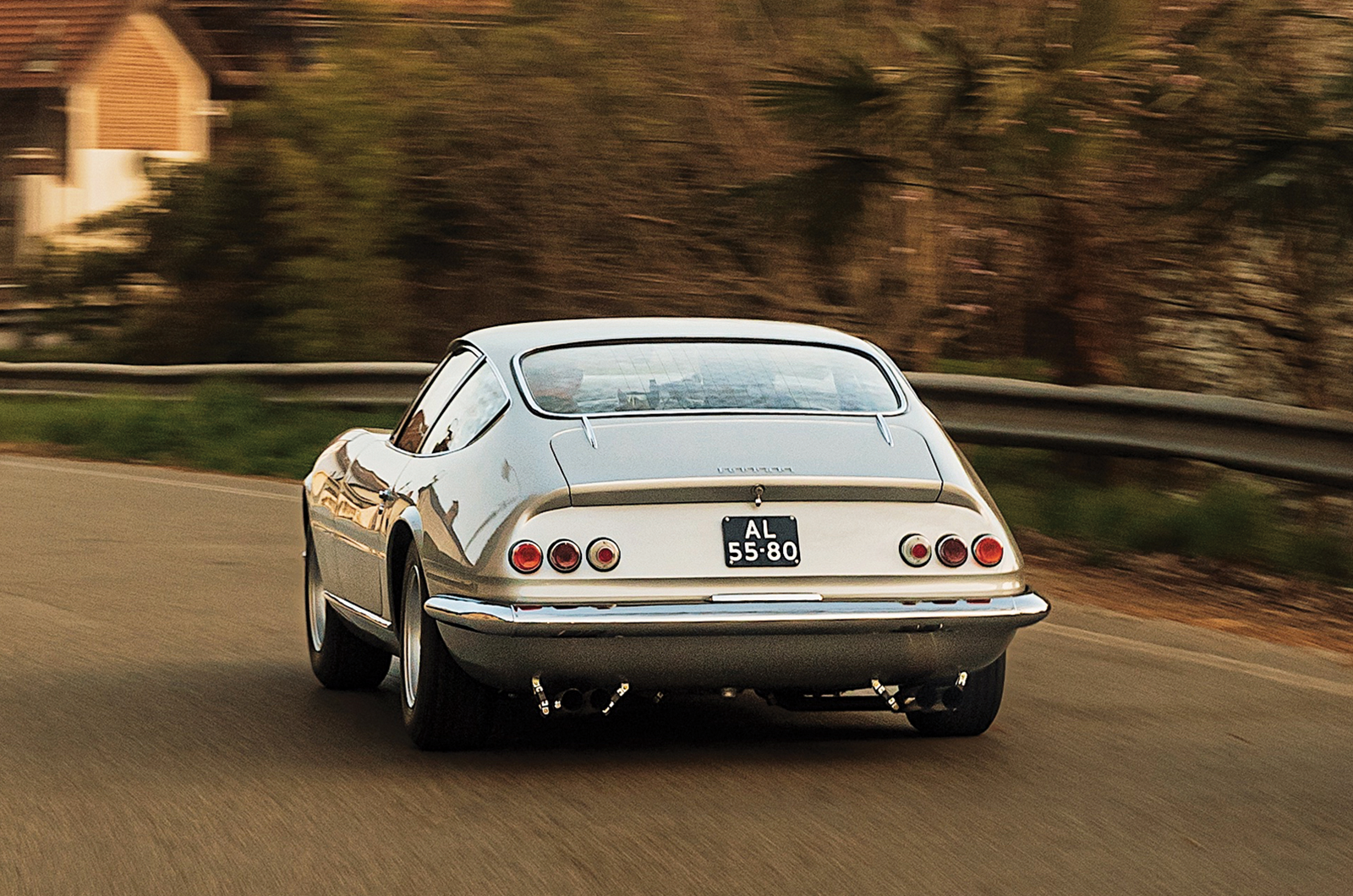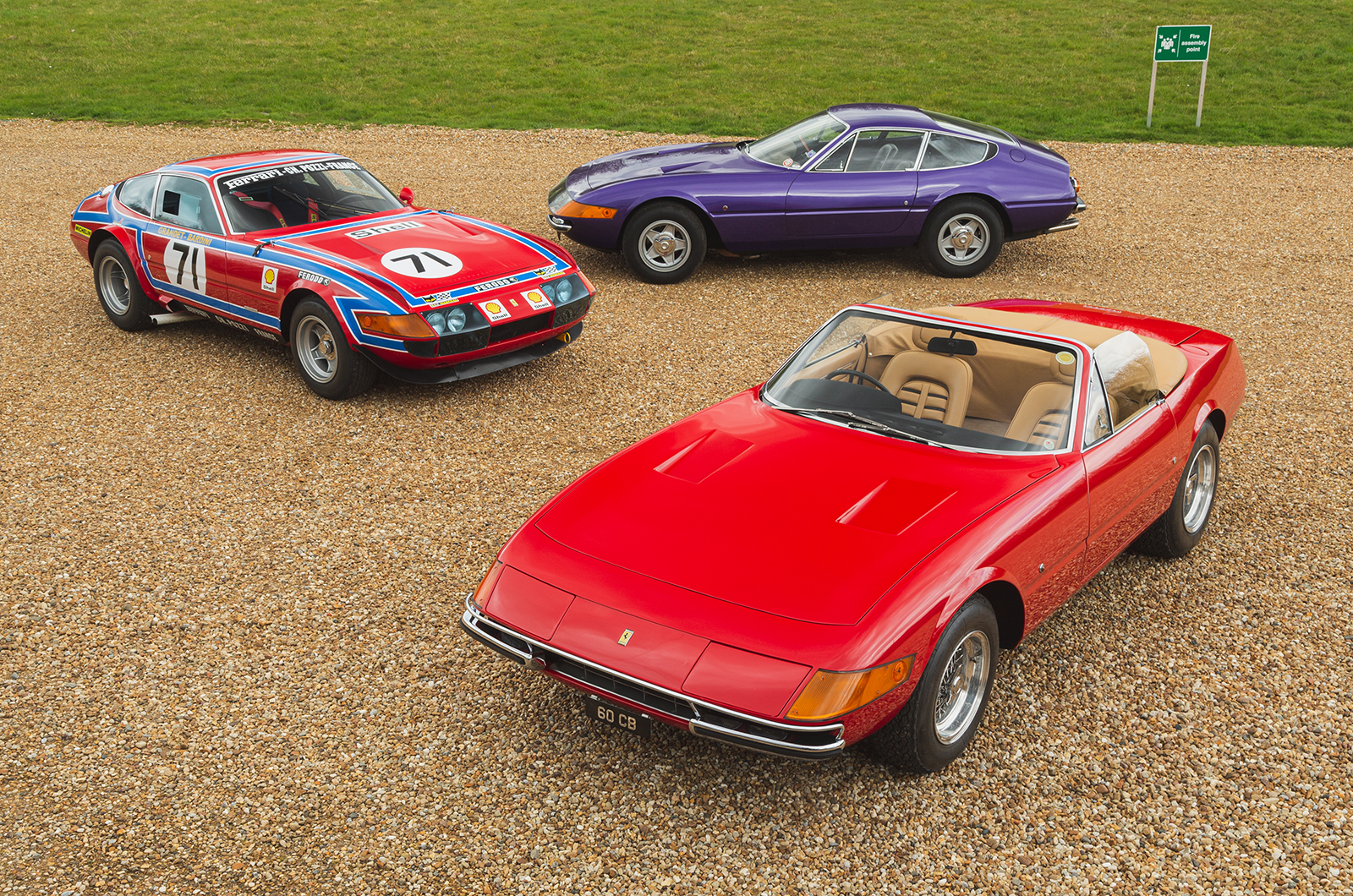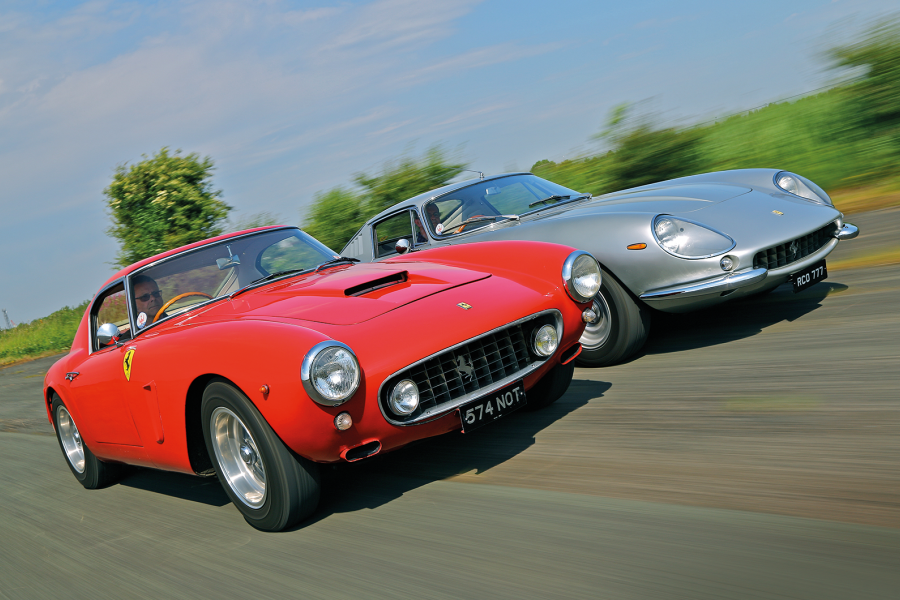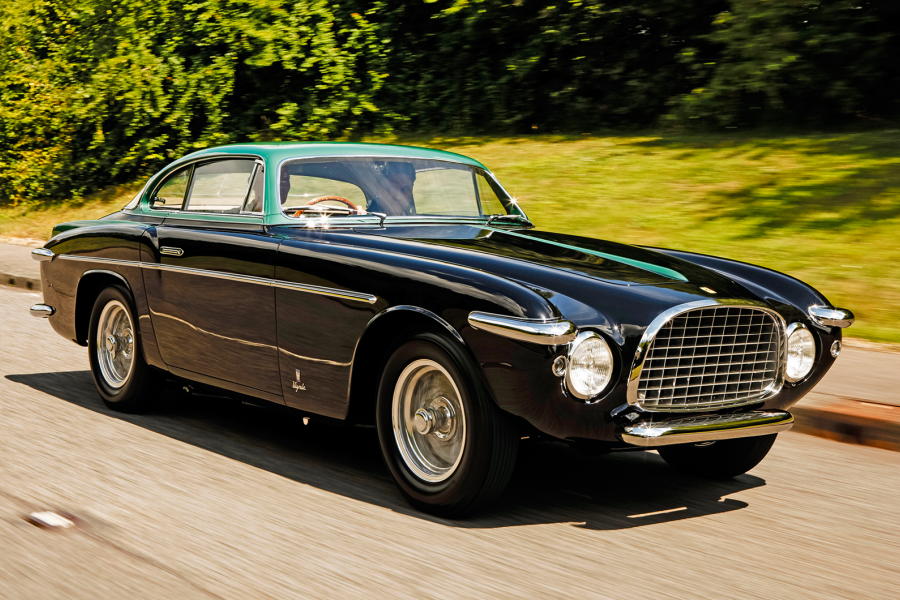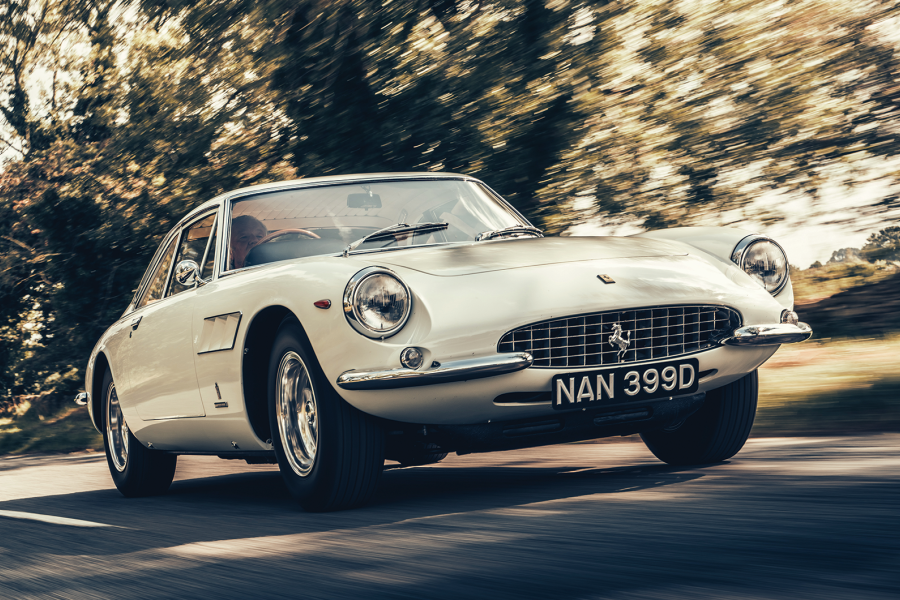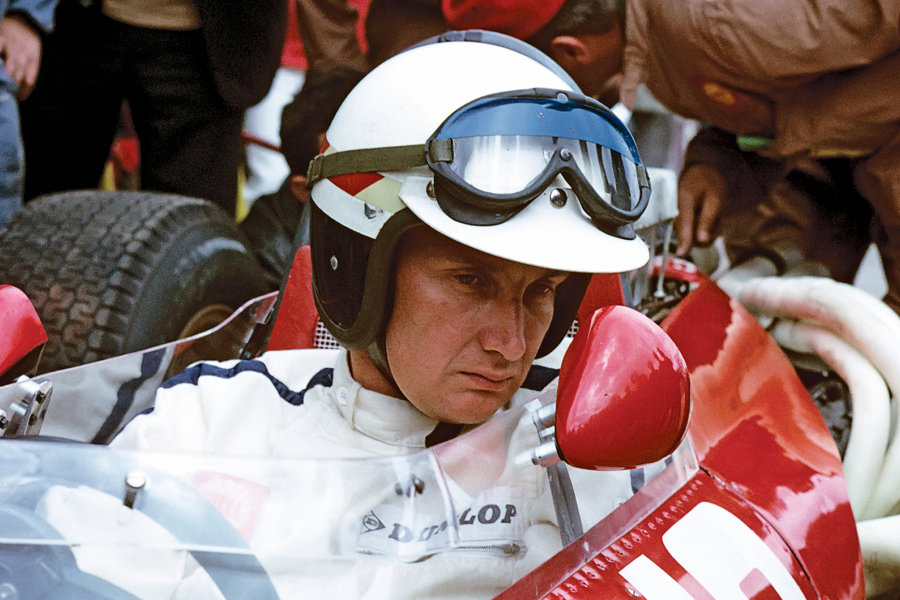The Daytona is a physical car to drive: clutch, gearbox and steering all require firm inputs, although not to an unacceptable level.
The engine, initially quite subdued, really gets into its stride from 3500rpm.
As soon as both of the Webers’ chokes open, the full majesty of the V12 is released, and if you keep it percolating between 4000 and 6000rpm you’re rewarded with one of the all-time great automotive soundtracks.
There’s no scuttle shake from the Spider’s roofless but reinforced coachwork
It’s immensely flexible, too, pulling heartily from lower revs if required.
After a few laps of familiarisation, you realise how planted and stable the car is as the speeds increase: blind crests are dismissed with barely a wobble from the body and, despite pushing hard, only the merest hint of understeer is detectable.
What it lacks in terms of the pin-sharp turn-in and ultimate precision of a mid-engined car, the Daytona gains with a dynamic reassurance that few powerful GTs of this vintage could carry.
The thunderous GTB/4 Competizione is fast, brash and raucous
By sheer coincidence, ‘our’ 365GTS/4 Daytona Spider was delivered new to the same first owner as the Gilbart-Smith car, exactly a year later, in August 1971.
It was the last of only seven factory right-hand-drive cars to be produced from a total Spider production run of 122, and was once in Anthony (now Lord) Bamford’s ownership.
It has been residing with its current keeper for the past 32 years, looked after by Cottingham Blue Chip London.
This car’s Competizione conversion took place in 1983 for historic racing
The Spider was revealed at the 1969 Frankfurt show and, since the Daytona had been originally designed as a large-window fastback, significant structural reinforcement was needed to compensate for the loss of rigidity, as well as some new upper-body components such as the bootlid and windscreen frame.
In addition, most Spiders were equipped with Borrani wires, as opposed to the standard five-spoke Campagnolo or Cromodora alloys fitted to the Berlinetta.
Due to US safety regulations, all Spiders other than the original Frankfurt show car (and, from 1971, all Berlinettas) also switched to pop-up headlights, replacing the original Plexiglas nose.
The bodywork is by Brandoli, the same company that converted the factory cars
This near-perfect Rosso Chiaro Spider is clearly a cosseted car, having only covered 1000 miles in the past 12 years, and all of its main controls feel more crisp than those in the well-exercised Gilbart-Smith Berlinetta.
Being a later model, there are some minor detail changes inside, such as black instead of chrome bezels around the dials.
The steering wheel is also leather-rimmed and of a smaller diameter, making the cabin feel more 1970s than ’60s.
On the Alpine Route, roof down, the Spider is in its element, its glorious symphony amplified somehow, despite the extra wind noise.
The racer is stiffer, lighter and much more eager to turn in
You notice slightly more hesitancy on initial turn-in to the faster bends, undoubtedly caused by the Spider’s extra mass (Autocar recorded the GTB/4’s weight as 3530lb, so both models are heavy for their class), but overall the car is remarkably well tied-down, with no significant structural shakes or shimmies.
Nothing, though, prepares you for the sheer brutality of the Competizione.
Ferrari built just 15 competition versions of the 365GTB/4 Daytona, in three separate batches of five between 1971 and 1973, along with two prototypes and eight factory-approved conversions.
The V12’s low-rev roar becomes an intoxicating shriek at higher speeds
The Series 1 cars were initially outclassed in Group 5, due to late completion of the 500 production cars needed for Group 4 homologation.
These were near-standard mechanically but their aluminium bodyshells featured glassfibre panels and, in some cases, plastic windows to reduce weight.
For 1972, the Series 2 Competizione engines had more aggressive cam timing and ported heads, and their compression ratios were raised from 9.3 to 10.1:1 to make 402bhp at 8300rpm.
Inside, most of the controls echo those on the standard Daytona
Their bodywork was significantly modified, to improve high-speed aero and cooling, as well as accommodating the 9in front and 11in rear wheels.
The final Series 3 cars in 1973 upped the ante yet further, with more suspension upgrades and 450bhp extracted from the still-4390cc V12.
The cars were never campaigned by Ferrari’s official works team but had particular success at Le Mans, including a fifth overall in 1971, and GT class wins between 1972 and ’74.
‘The V12 idles with a staccato cackle, but you don’t expect this most radical Daytona to be the sweetest driver of the three’
DK Engineering’s Competizione is not a factory car but a matching-numbers production Daytona converted in 1983 to full Group 4 spec for use in historic racing.
The car was sent to Modena, with bodywork completed by Brandoli (which converted the factory cars) and engine work by renowned expert Sauro.
Resplendent in red, and sporting twin exhausts sprouting from each side ahead of flared rear arches, this Competizione is a thing to behold.
A race harness straps you into the Competizione
Blue fabric race seats greet you as you enter the well-trimmed cabin and strap yourself in with the Sabelt race harness.
It’s a left-hooker so there’s no gaiter masking the open gearshift gate, but most other controls and instruments ape those of the production cars.
Turn the ignition key and the barely silenced 4.4-litre V12 idles with a staccato cackle; you’re already in the paddock at Goodwood.
What you don’t expect is for this most radical Daytona to be the sweetest driver of the three.
Big flared arches and side-exiting pipes complete this Ferrari racer’s bold looks
Data suggests that the S2 and S3 cars (DK’s is based on the latter) were around 400lb lighter than the production Berlinettas, and you feel that reduction in mass at the first bend, the Competizione darting towards the apex with an eagerness denied its road-based siblings.
The structure is also much stiffer – aided by the full rollcage – which, when you build up speed, takes the body control to a new level.
And that engine… It’s more peaky than in the other cars, making maximum power at 8300rpm, but the deep, unmuted roar that turns to a high-pitched wail through those open exhausts as you near redline revs is utterly spellbinding.
It’s the perfect finale for the Daytona, said to be the last road car whose development Enzo personally oversaw.
So not only does this trio represent a final link with epic models from the past, but with the old man himself.
Images: Luc Lacey
Thanks to: UTAC Millbrook; DK Engineering; the Gilbart-Smith family; Cottingham Blue Chip London Ltd
Ferrari Daytona: where it all began
The first four Ferrari Daytona concepts used headlamps from the 275GTB/4 © Alberto Chimenti Dezani/RM Sotheby’s
The very first 365GTB/4 prototype, chassis 10287, was completed in 1967, prior to five further prototypes being built before Daytona production commenced.
Only the first four adopted this car’s hybrid look, melding the long, curved nose, bonnet bulge and Perspex-cowled twin headlights of the outgoing 275GTB/4 with a near-identical roofline and rear-three-quarter design to that of the incoming production car.
Six rather than four Carello tail-lights and a full-width rear bumper also deviated from the Daytona’s final specification.
The prototype’s Tipo 283 engine was completely bespoke and never used in the production 365GTB/4.
Based on the 330GT block but bored out to 4380cc, it featured three valves per cylinder (two inlet, one exhaust, like the P4 racers) versus the 330's two, along with a dry sump and six Weber 40 DCN18 carburettors.
There are plenty of hints at the Daytona’s final form in the rear-three-quarter bodywork © Alberto Chimenti Dezani/RM Sotheby’s
It was initially registered in May 1968 and its first private keeper was Count Vincenzo Balestrieri, to whom Enzo Ferrari loaned the car while the Count was waiting for delivery of his Daytona Spider.
It was then exported to the US and went through various owners before being brought back to Europe in 1989.
After it had changed hands twice more, in 2003 its Dutch keeper commissioned a full restoration.
Now Ferrari Classiche-certified, the car was displayed at the prestigious Museo Ferrari in 2015-’16 and was awarded Best of Show at the 2016 Concours d’Elegance Paleis Het Loo Apeldoorn.
Factfiles
Ferrari 365GTB/4
- Sold/number built 1968-‘73/1284
- Construction multi-tubular steel spaceframe chassis, aluminium panels
- Engine all-alloy, dohc-per-bank 4390cc 60° V12, six twin-choke Weber 40 DCN21 carburettors
- Max power 352bhp @ 7500rpm
- Max torque 318lb ft @ 5500rpm
- Transmission five-speed manual, RWD
- Suspension independent, by double wishbones, coil springs, telescopic dampers, anti-roll bar f/r
- Steering worm and nut
- Brakes Girling ventilated discs
- Length 14ft 6in (4420mm)
- Width 5ft 9¼in (1760mm)
- Height 4ft 1in (1244mm)
- Wheelbase 7ft 10½in (2400mm)
- Weight 3530lb (1601kg)
- 0-60mph 5.4 secs
- Top speed 174mph
- Mpg 12.4
- Price new £9998 (1971)
- Price now £600,000*
Ferrari 365GTS/4
Where different from GTB/4
- Sold/number built 1969-’73/122
- Weight n/a
- 0-60mph 6.7 secs
- Price new £10,251 (1971)
- Price now £4m (RHD, UK-supplied car)*
Ferrari 365GTB/4 C S3
Where different from GTB/4
- Sold/number built 1971-‘73/15 (plus eight factory-approved conversions)
- Max power 450bhp @ 8300rpm
- Max torque n/a
- Weight 3130lb (1420kg, est)
- Mpg n/a
- 0-60mph n/a
- Top speed n/a
- Price new n/a
- Price now £750,000 (test car)*
*Prices correct at date of original publication
Enjoy more of the world’s best classic car content every month when you subscribe to C&SC – get our latest deals here
READ MORE
Battle of the supercars: Miura vs Daytona vs Mangusta
Aston Martin DB5 vs Mercedes-Benz 300SL vs Ferrari 275GTB: million dollar babies
Driving the real Italian Job Miura
Simon Hucknall
Simon Hucknall is a senior contributor to Classic & Sports Car
